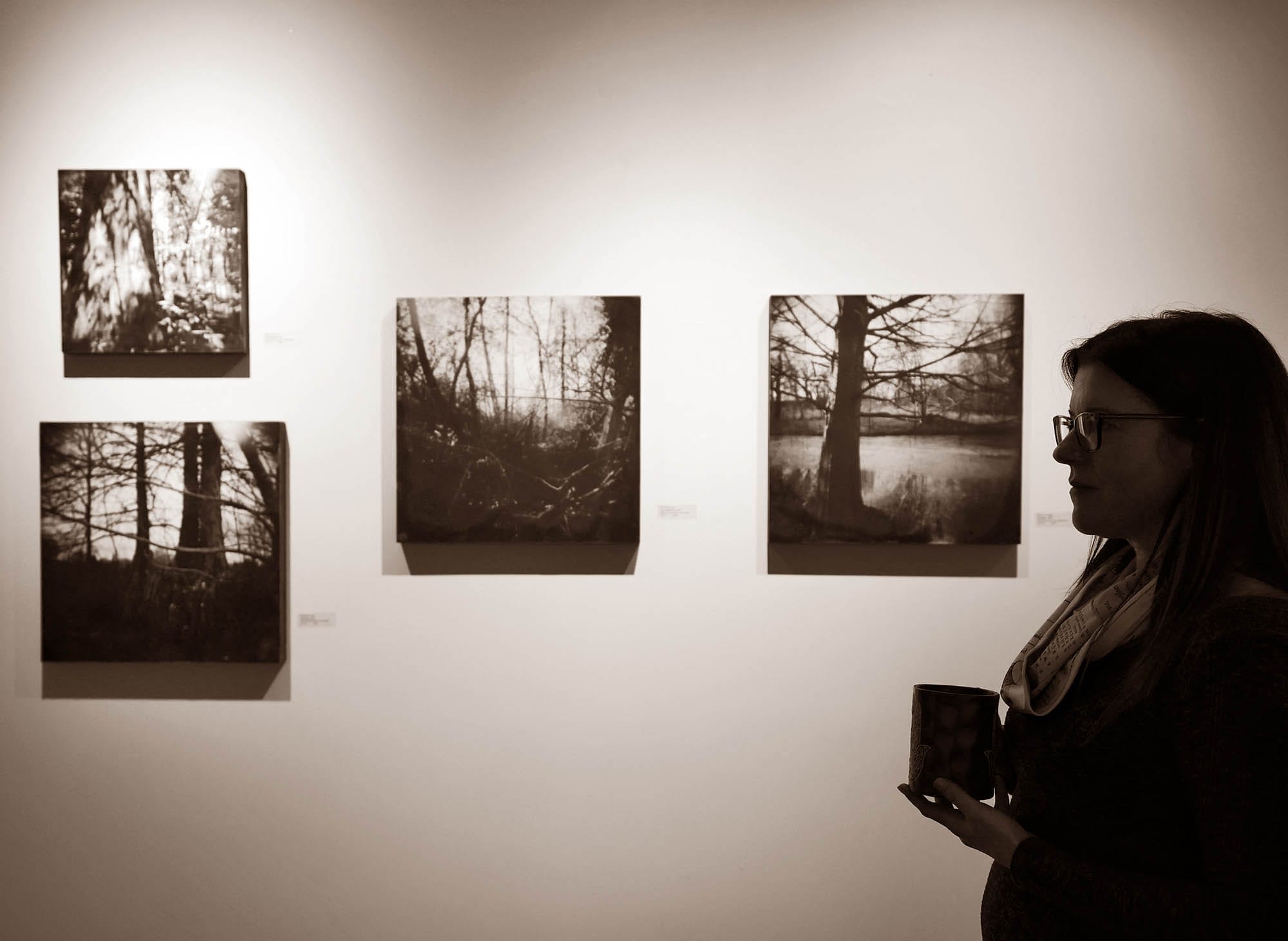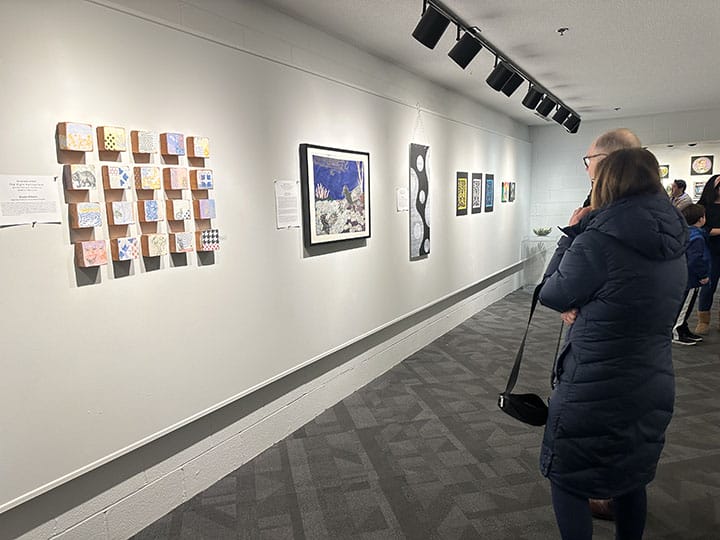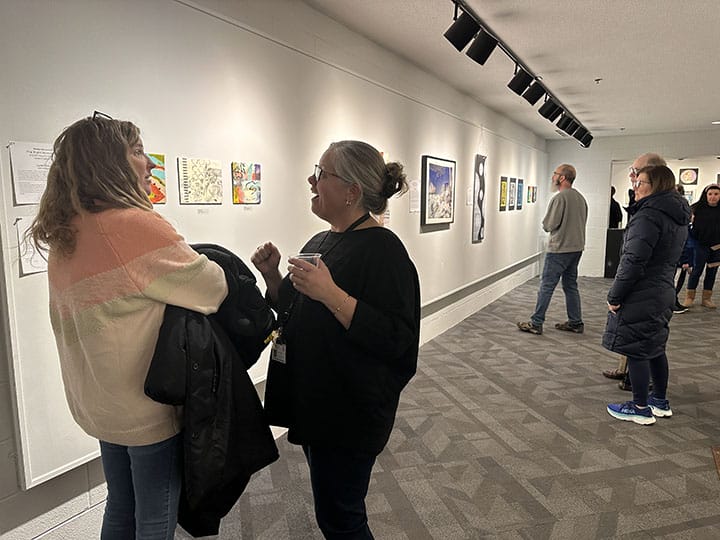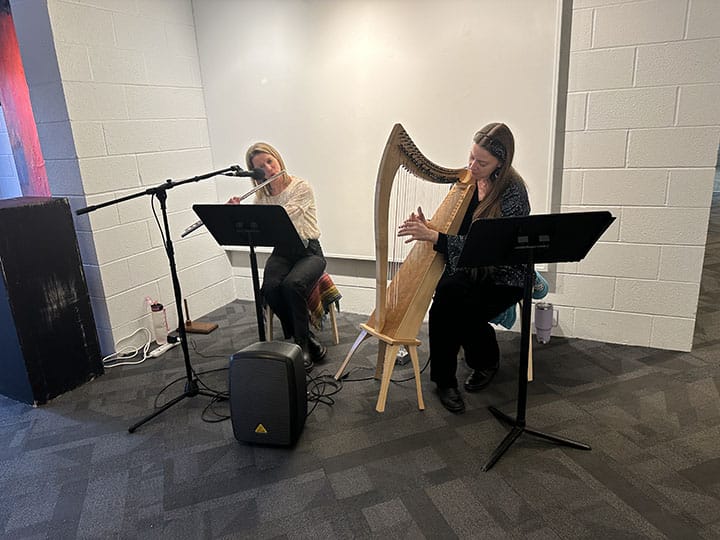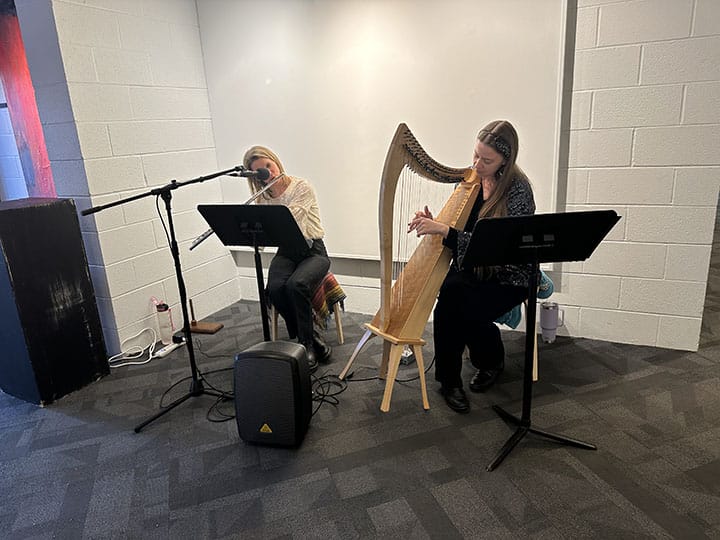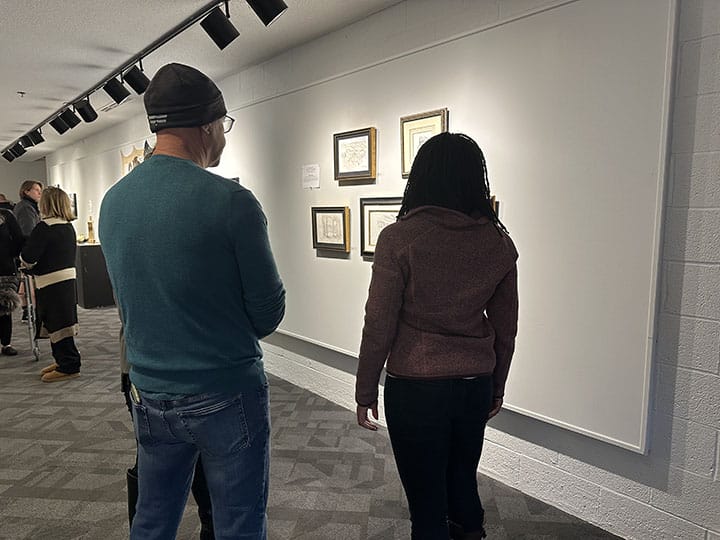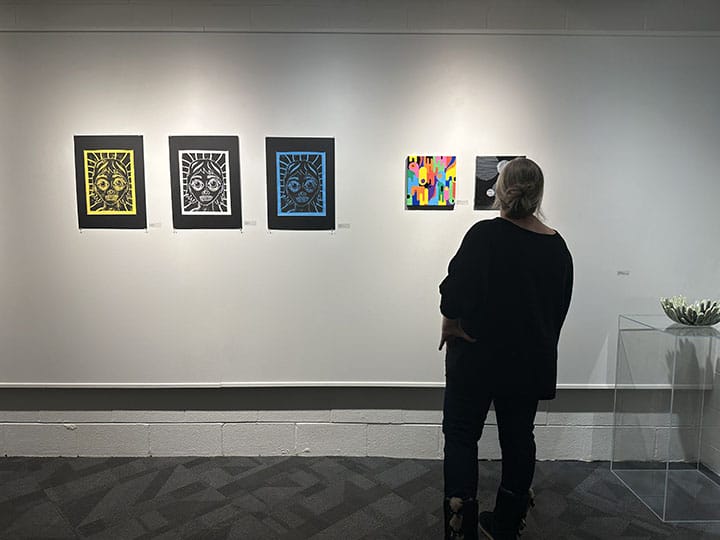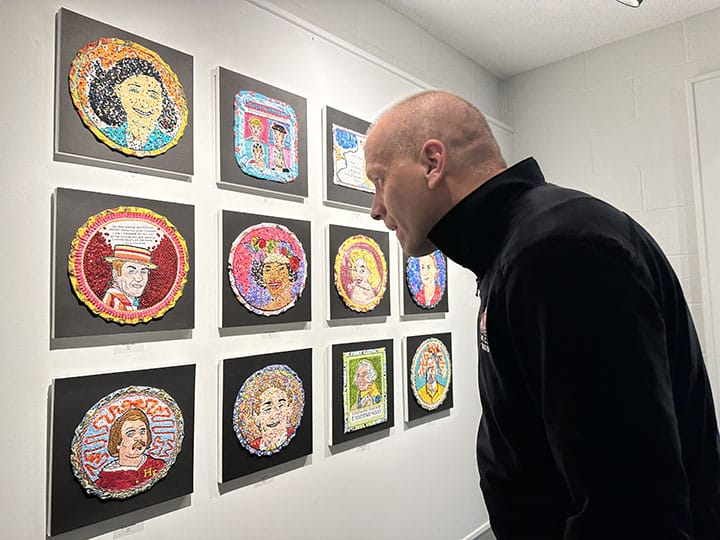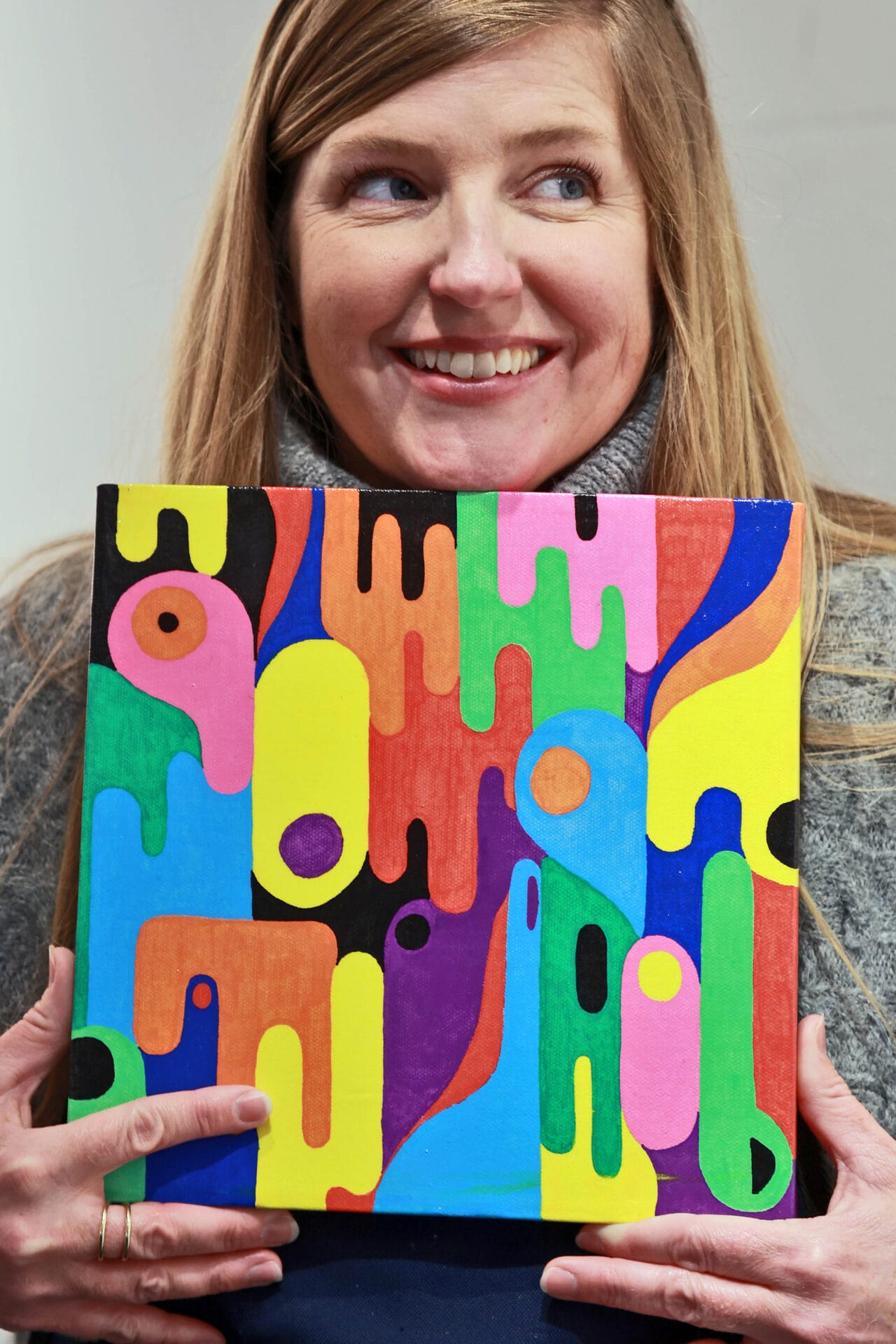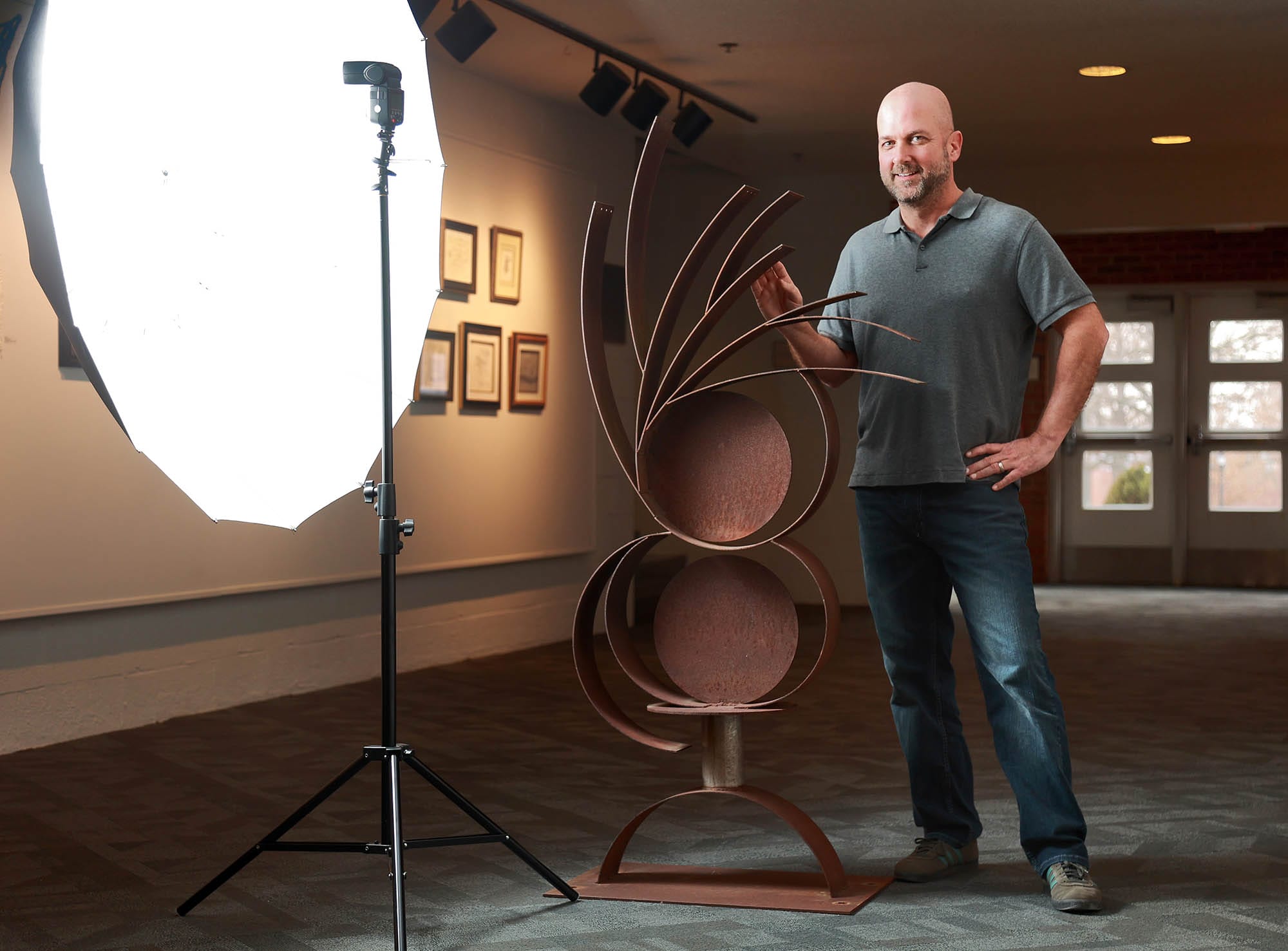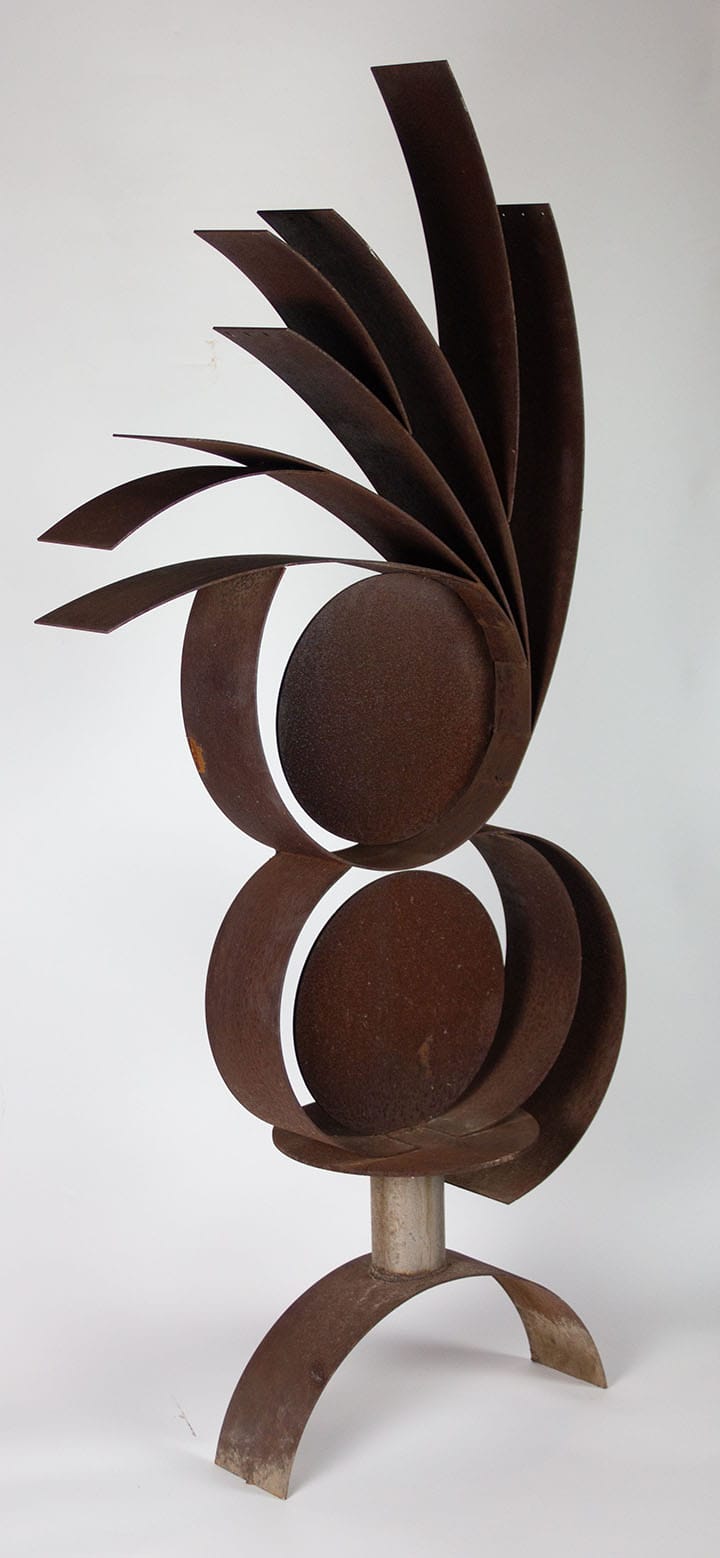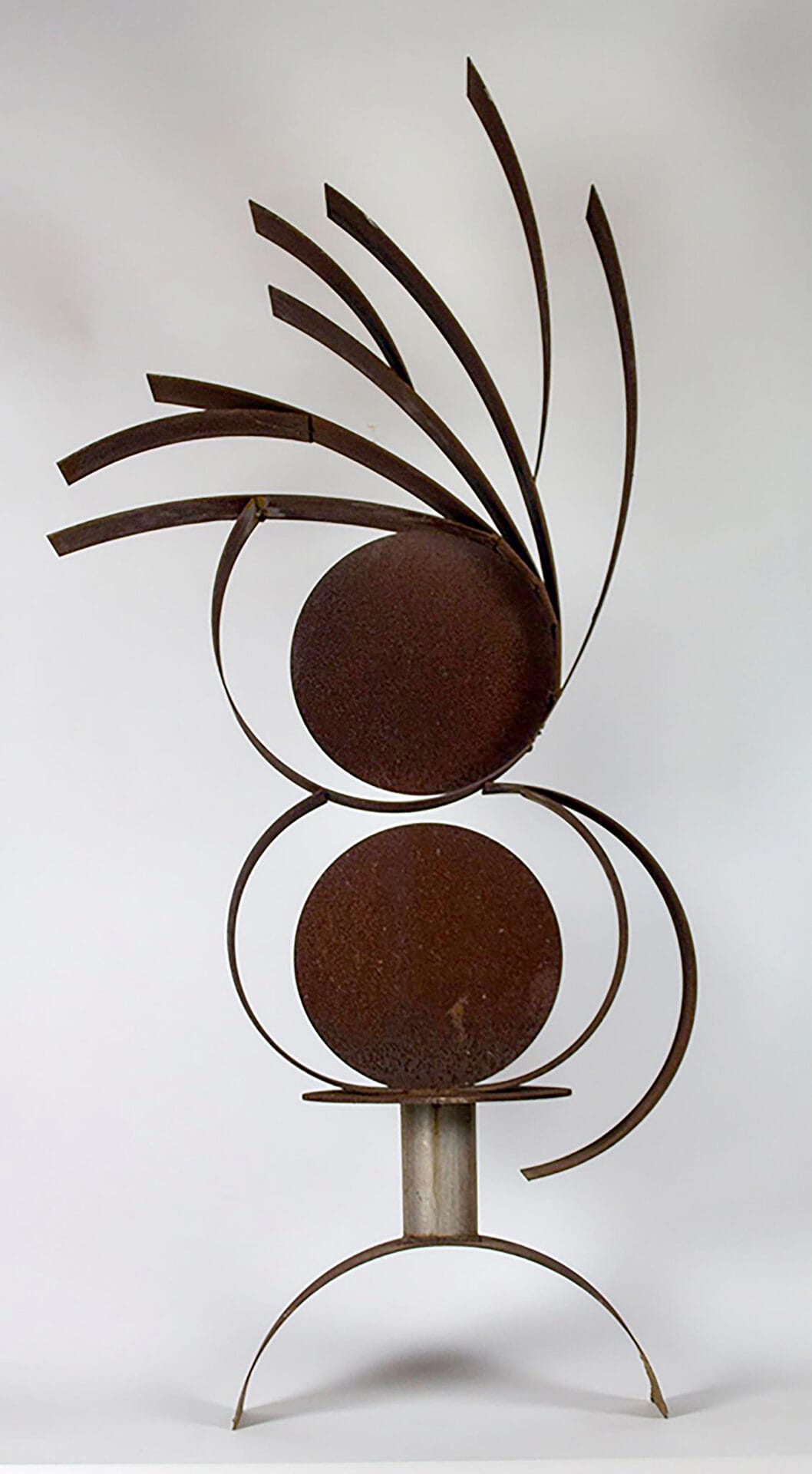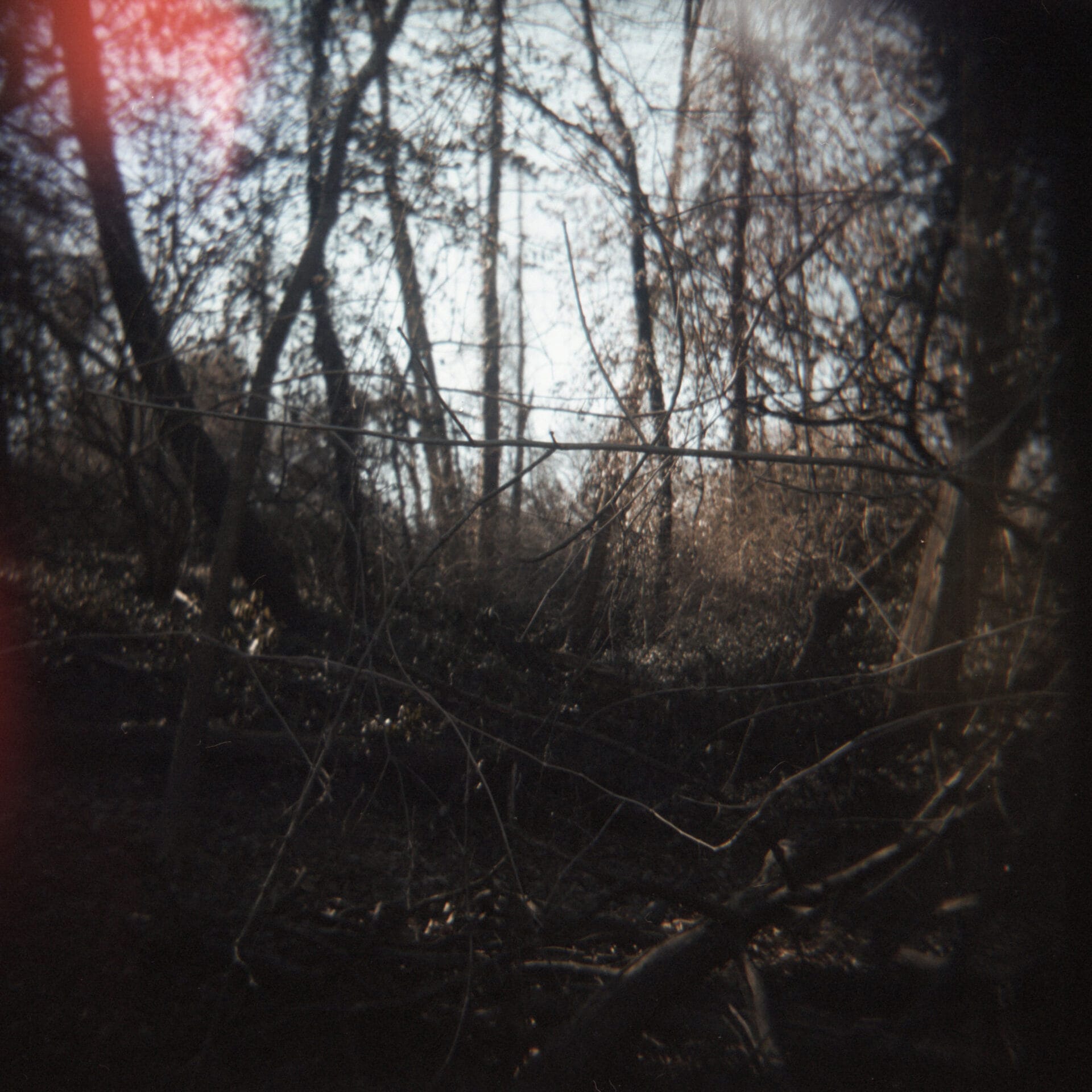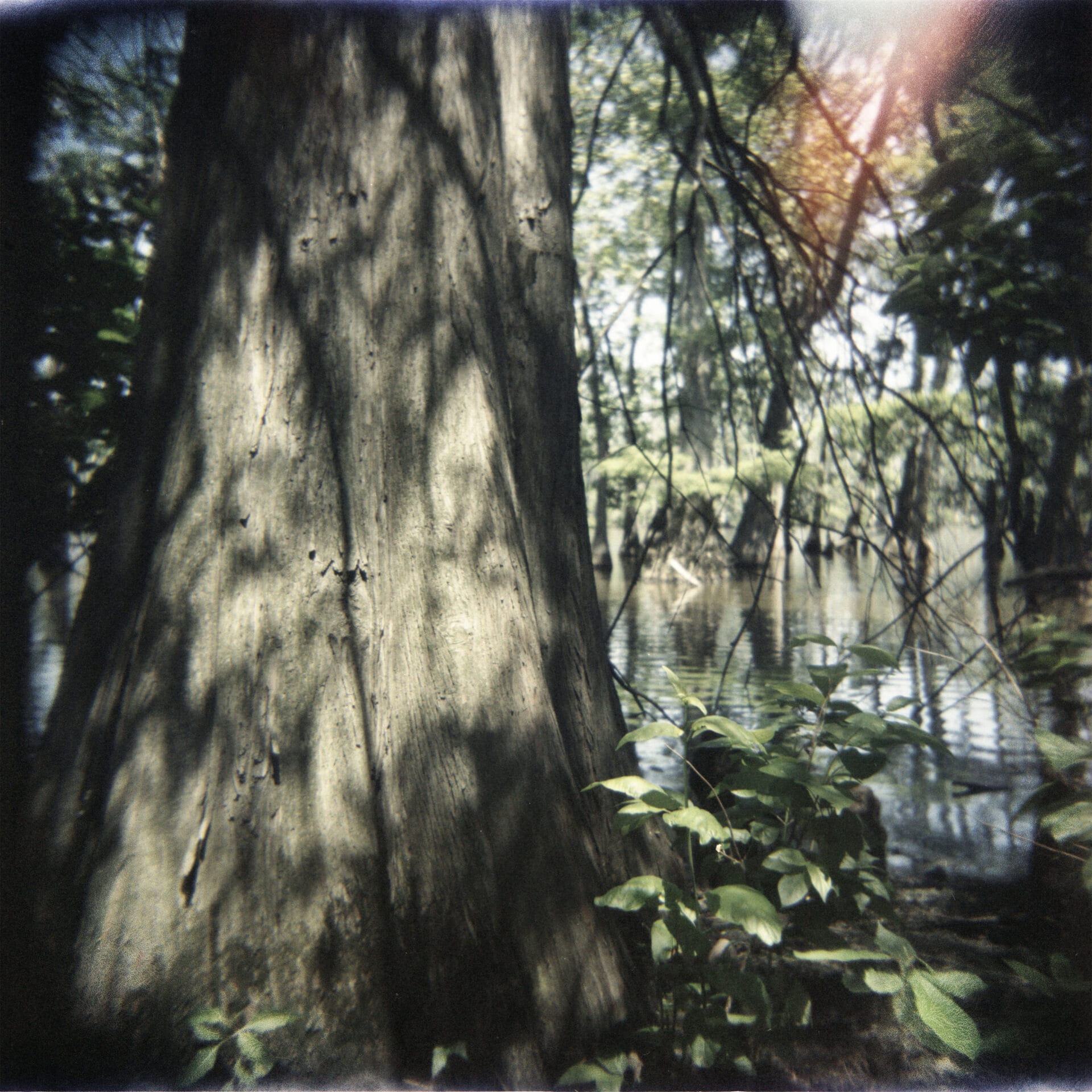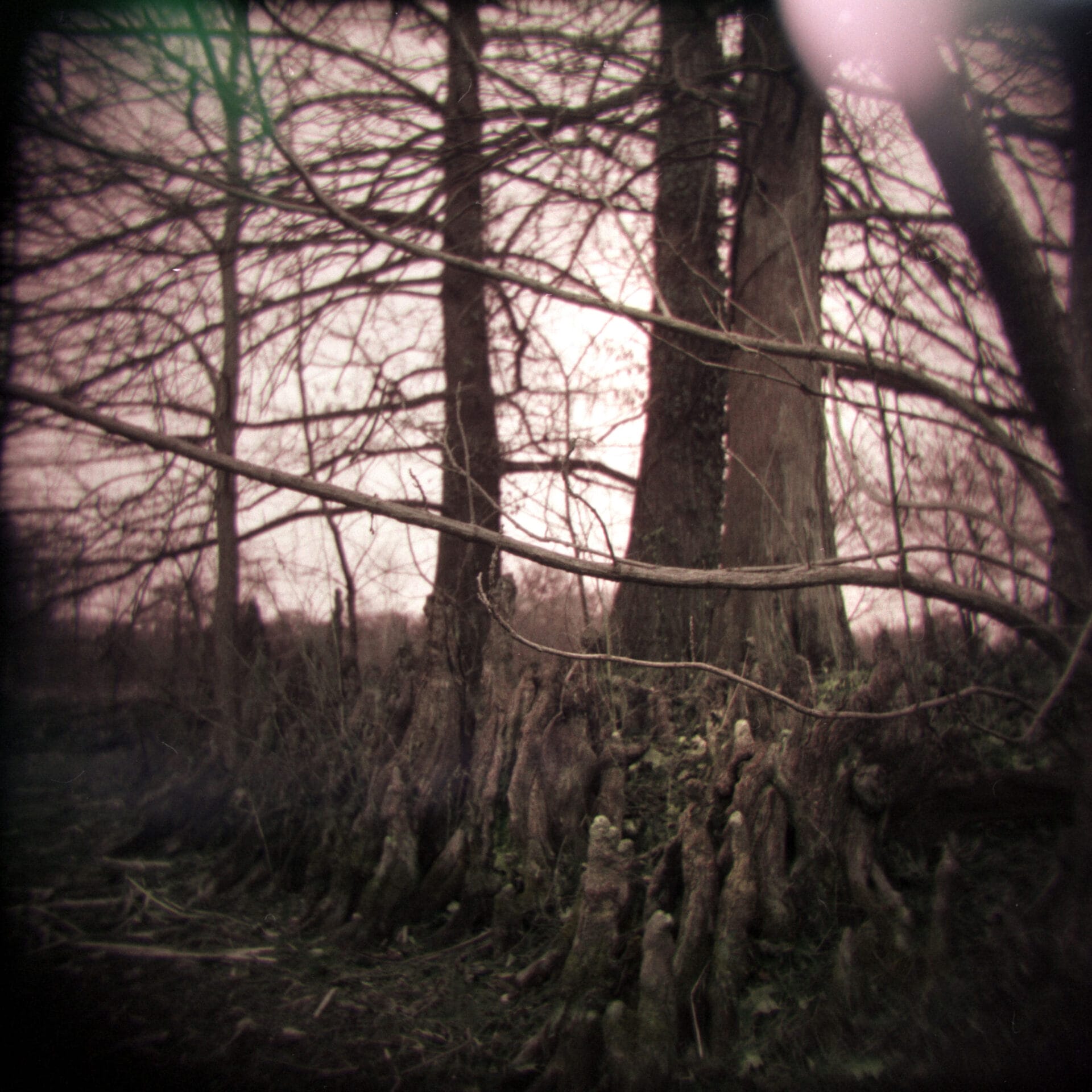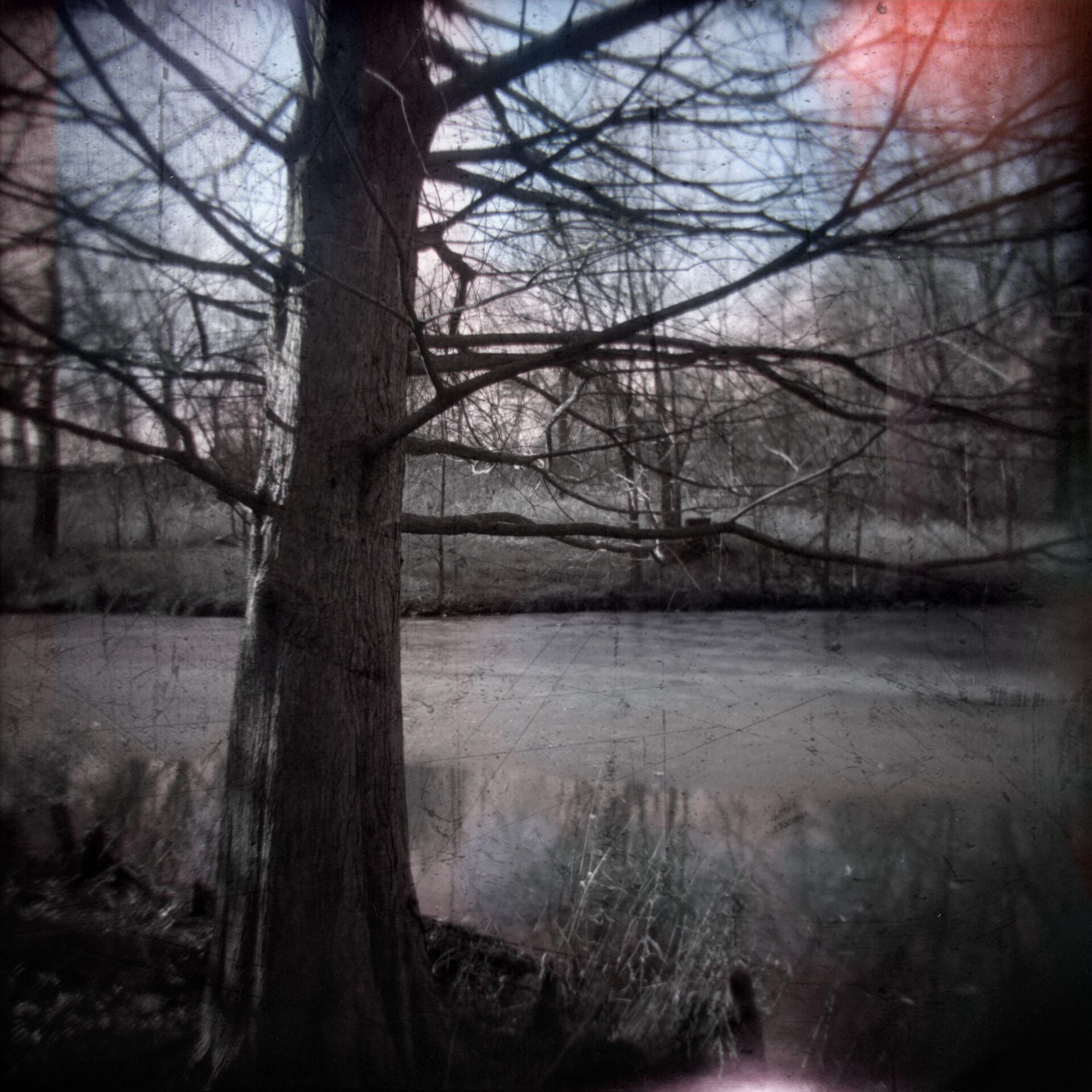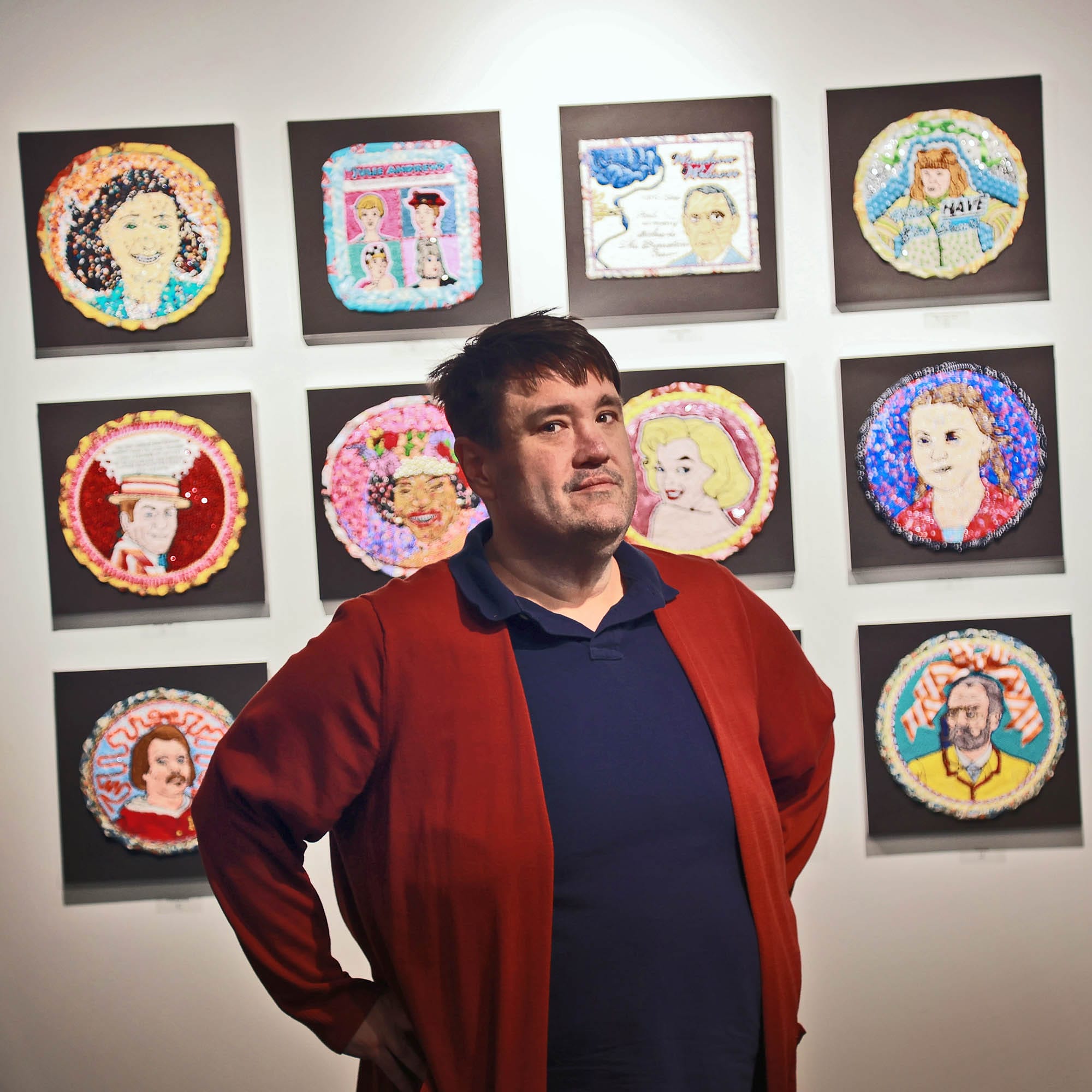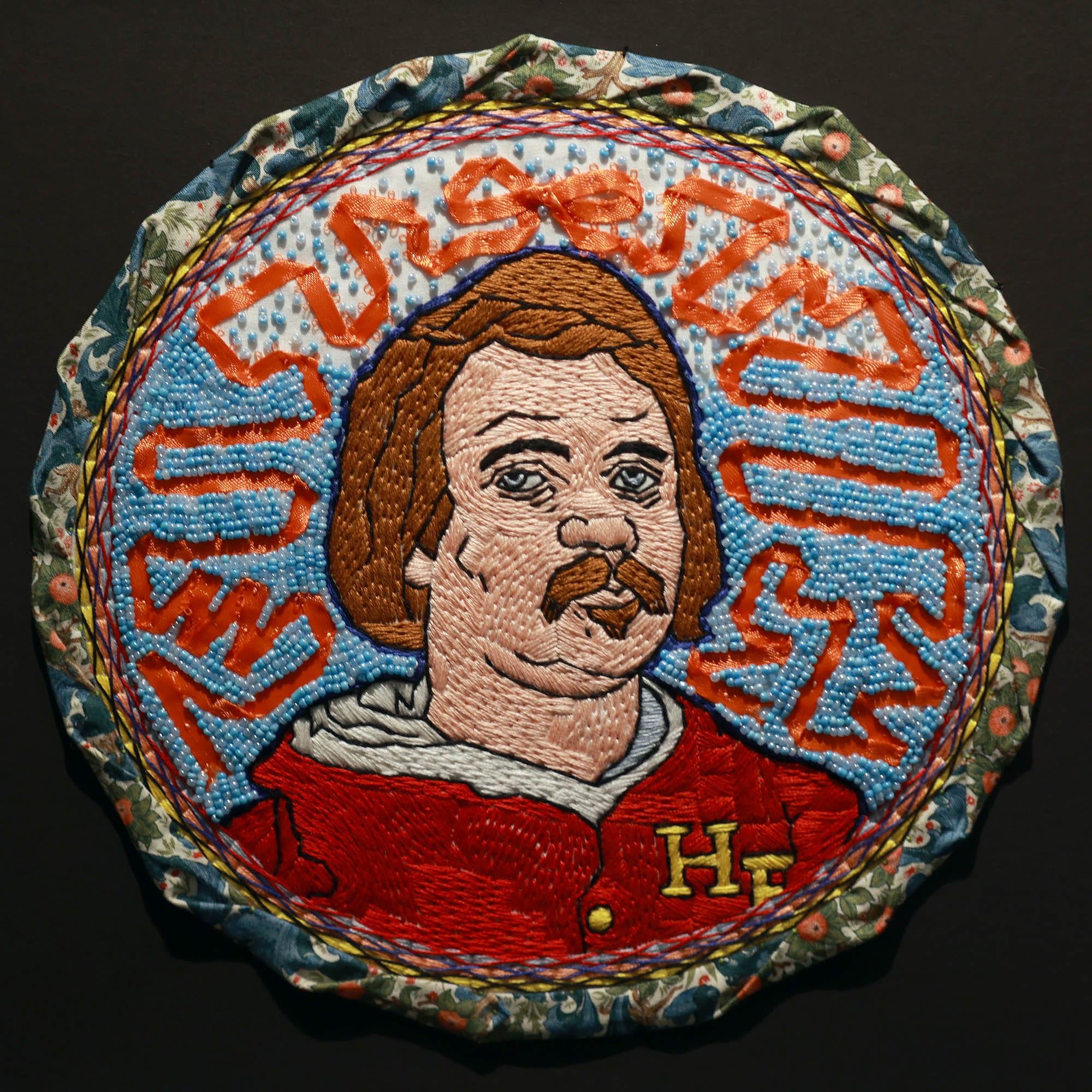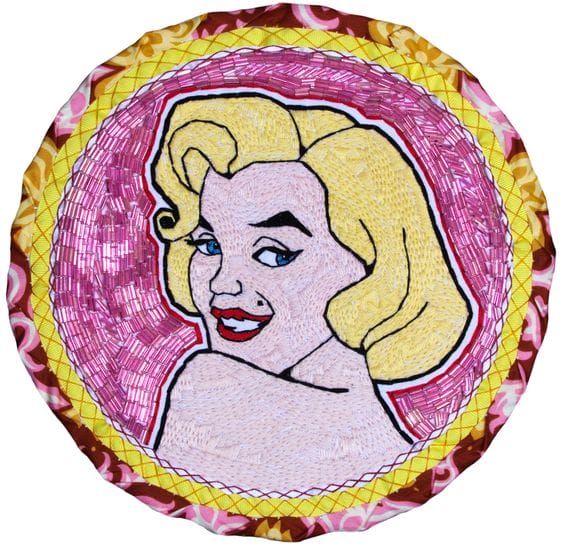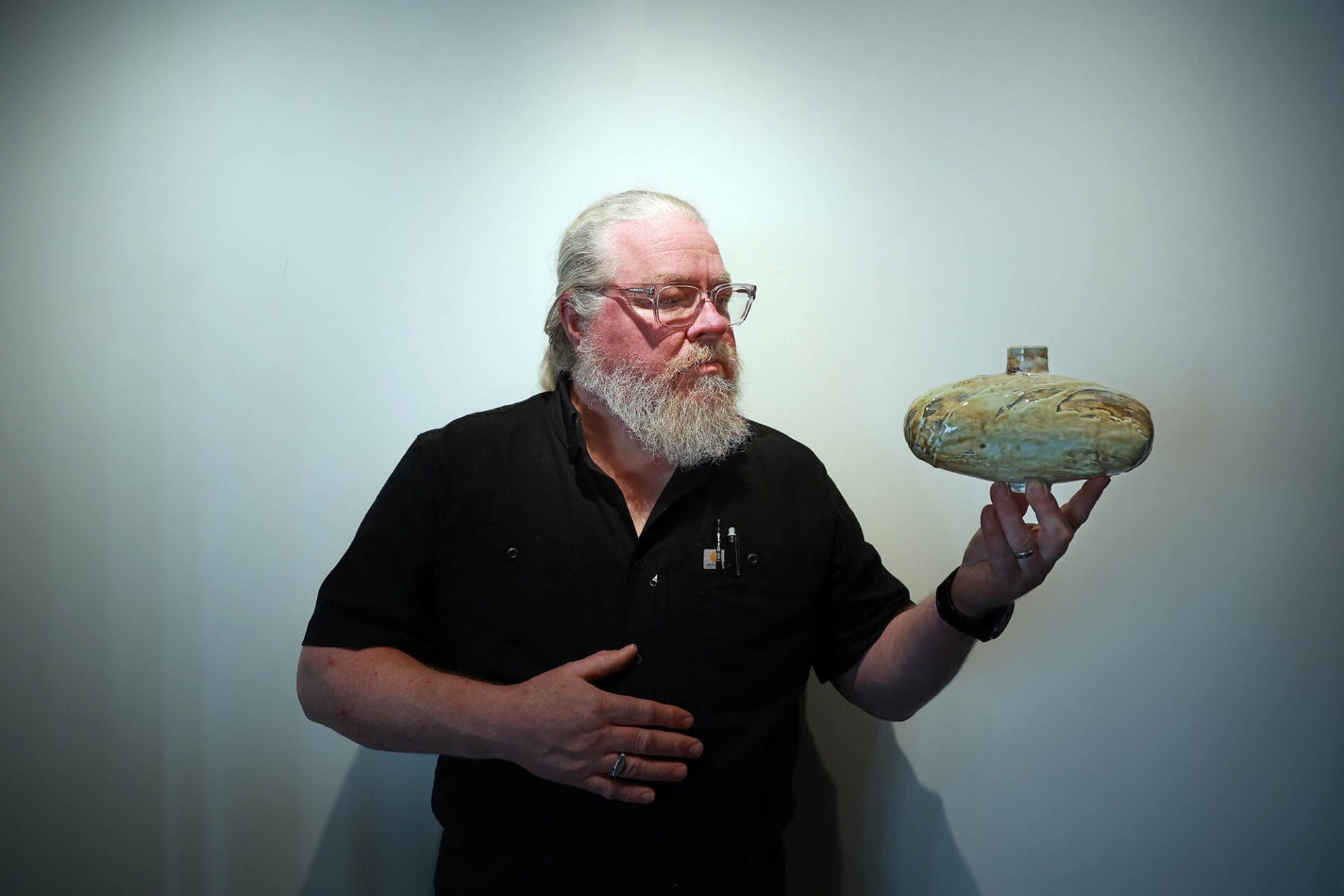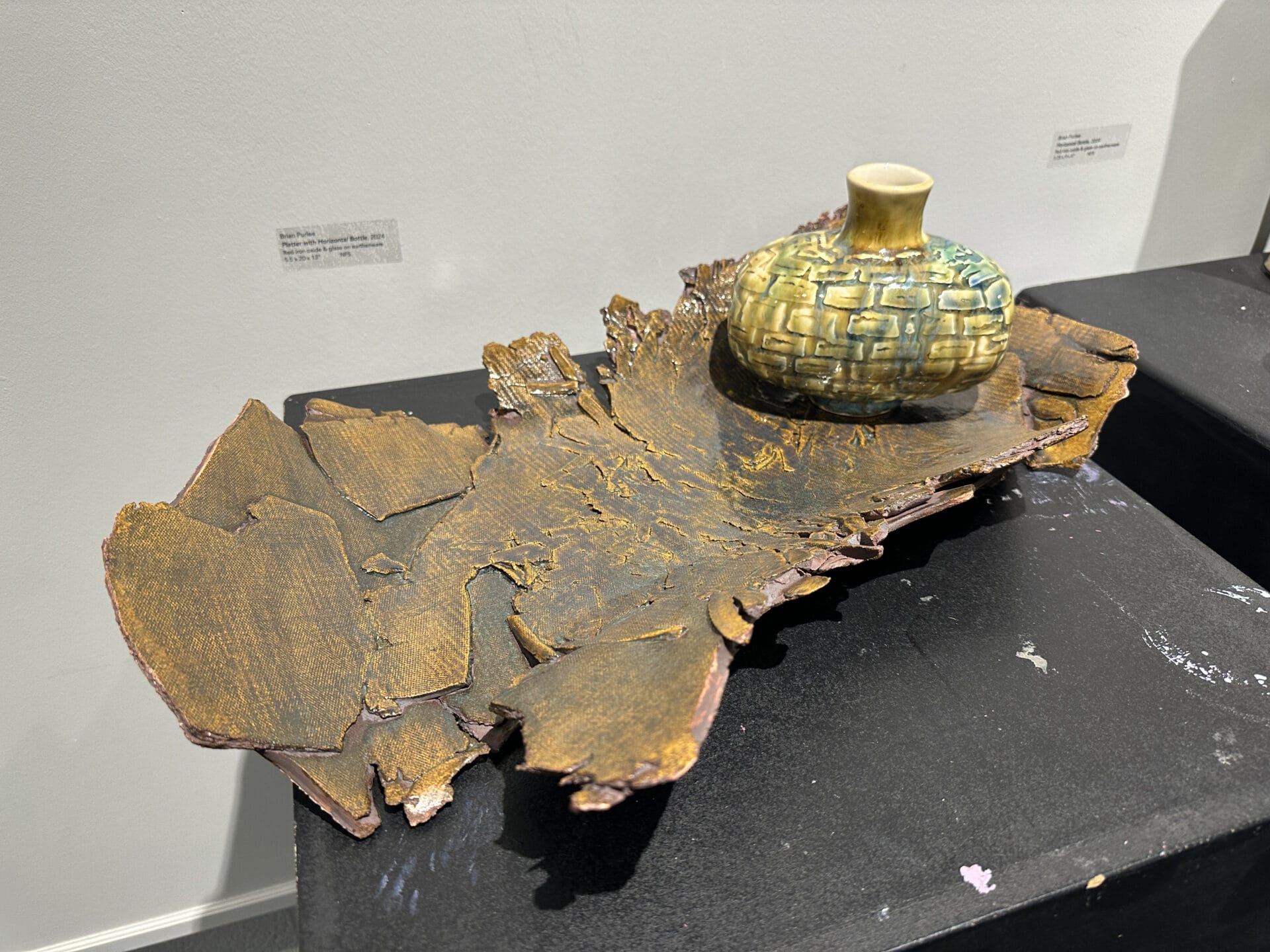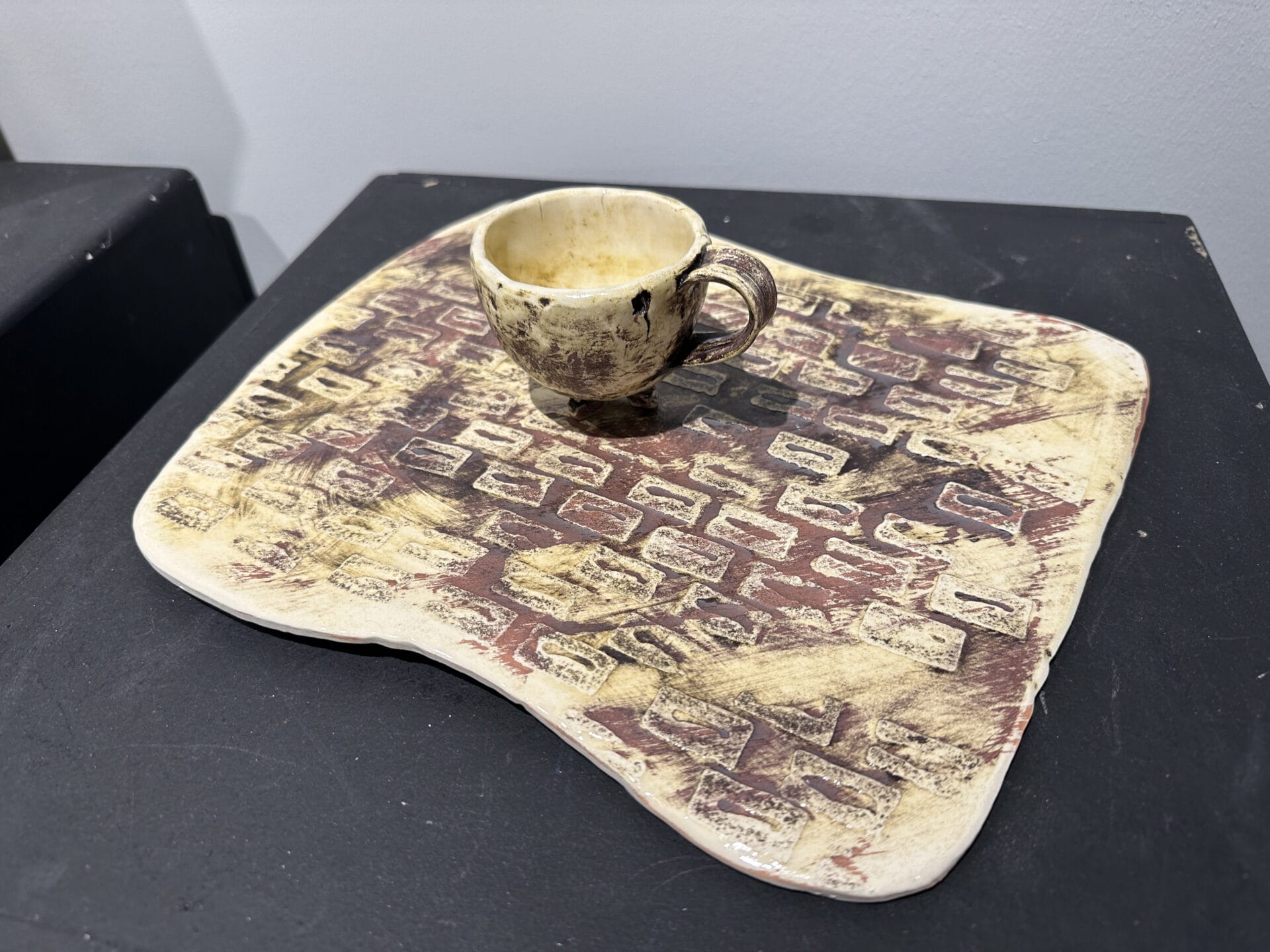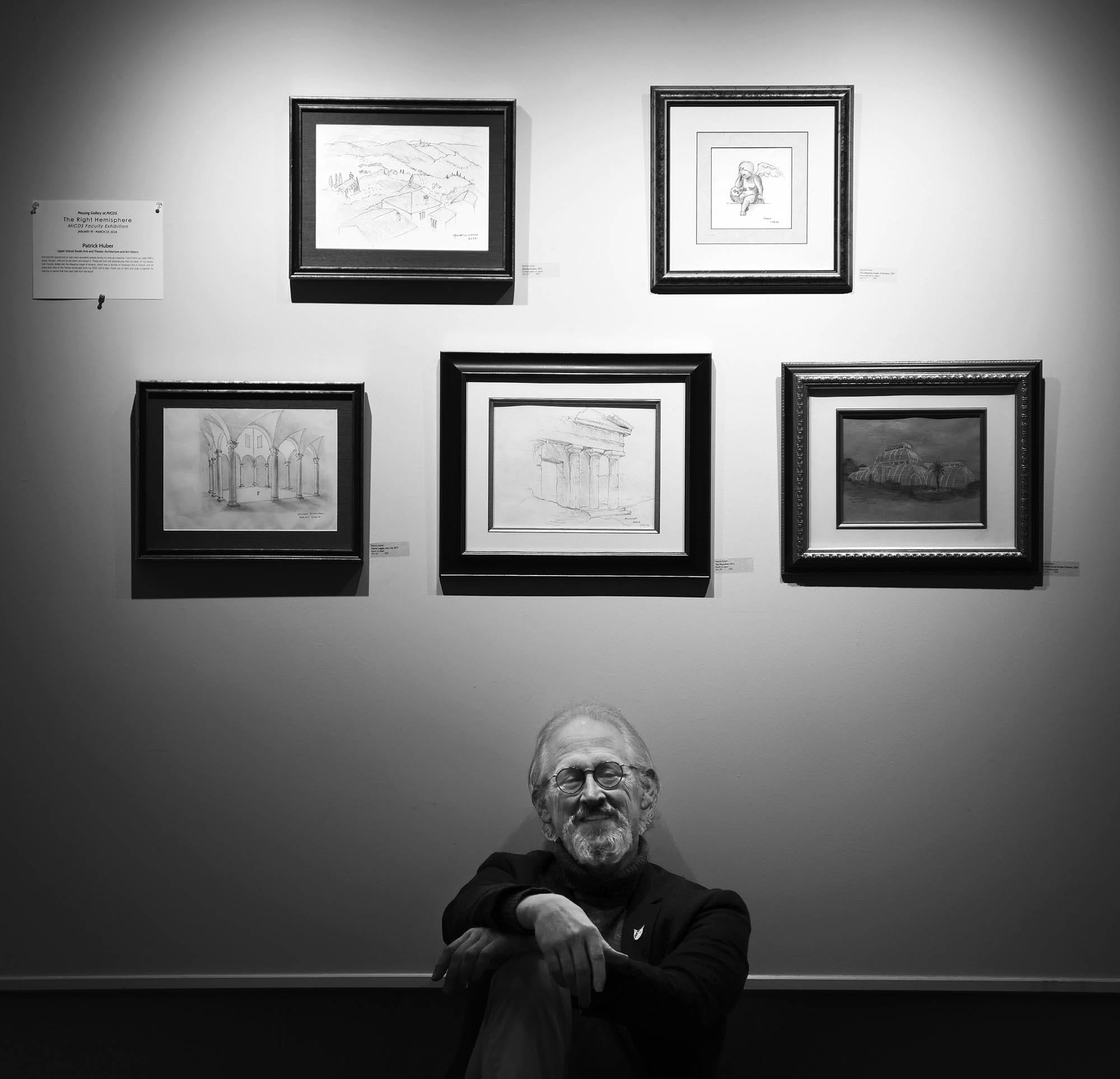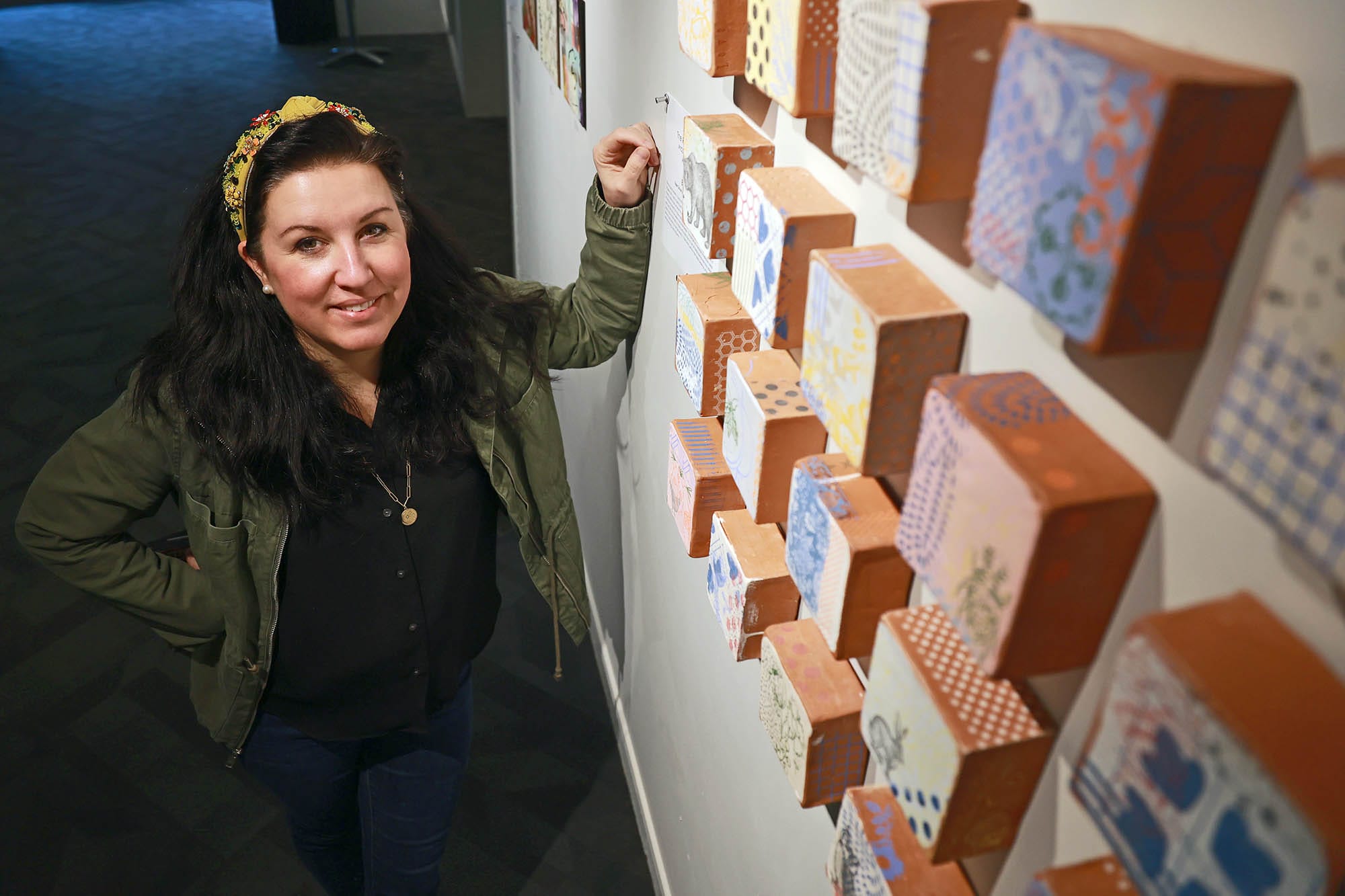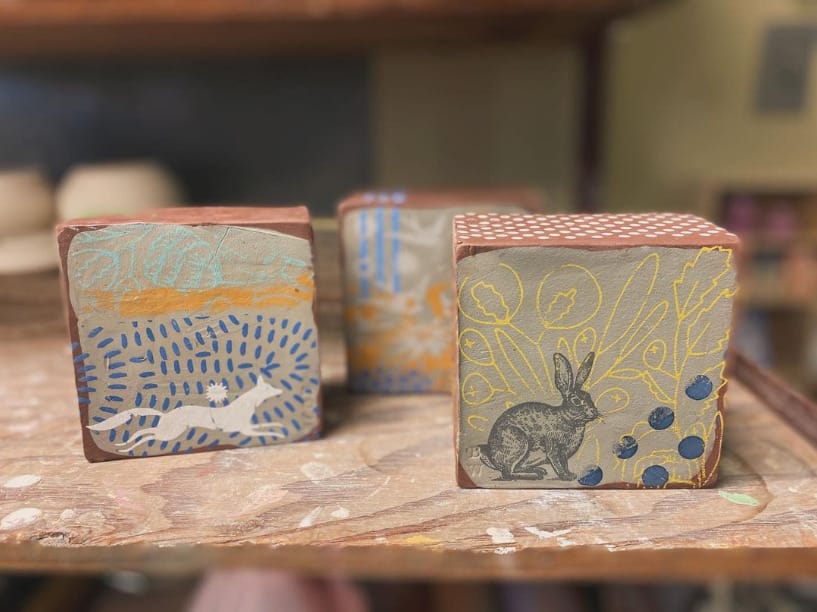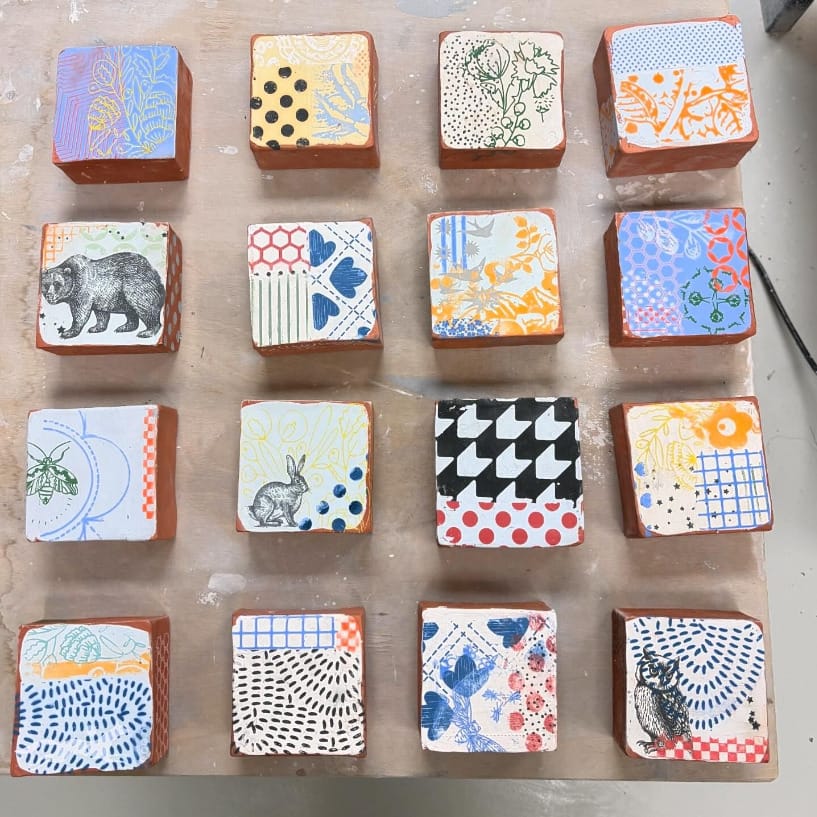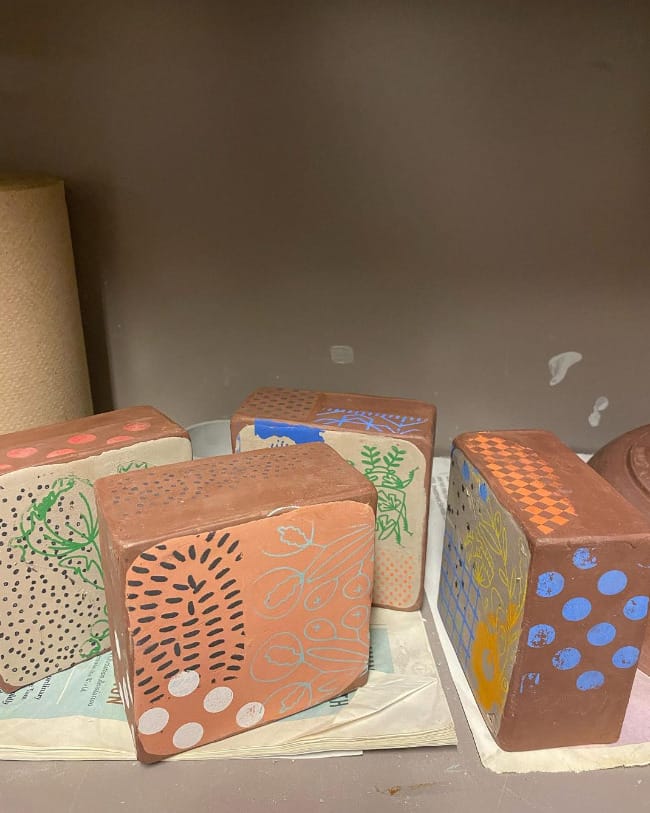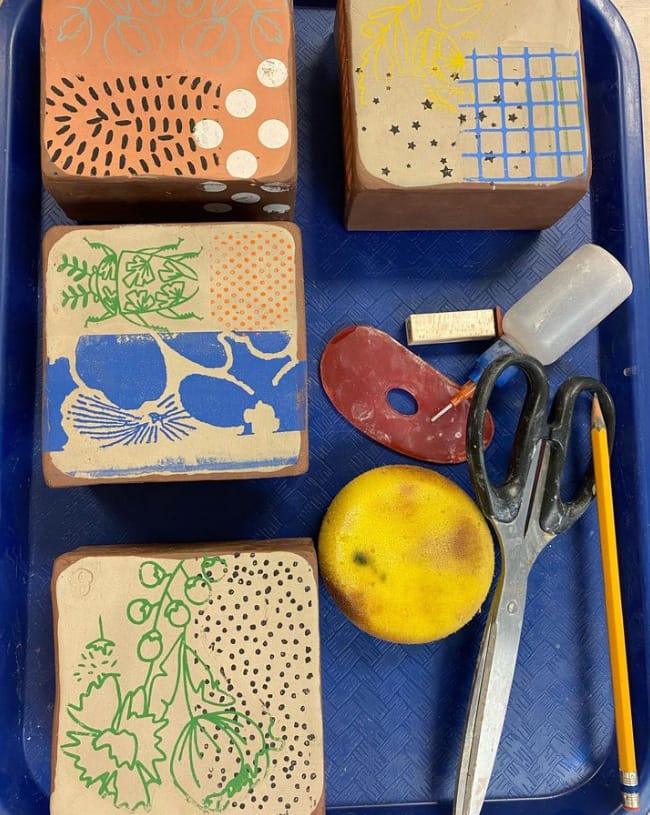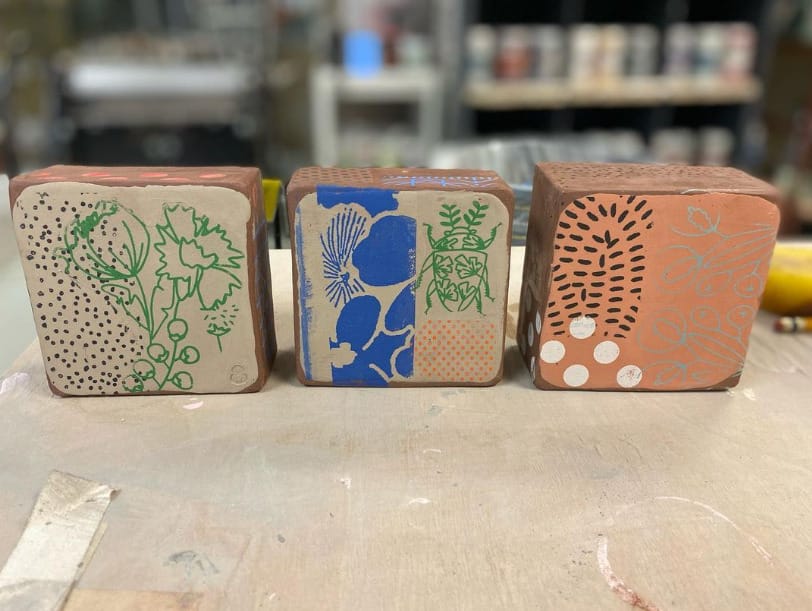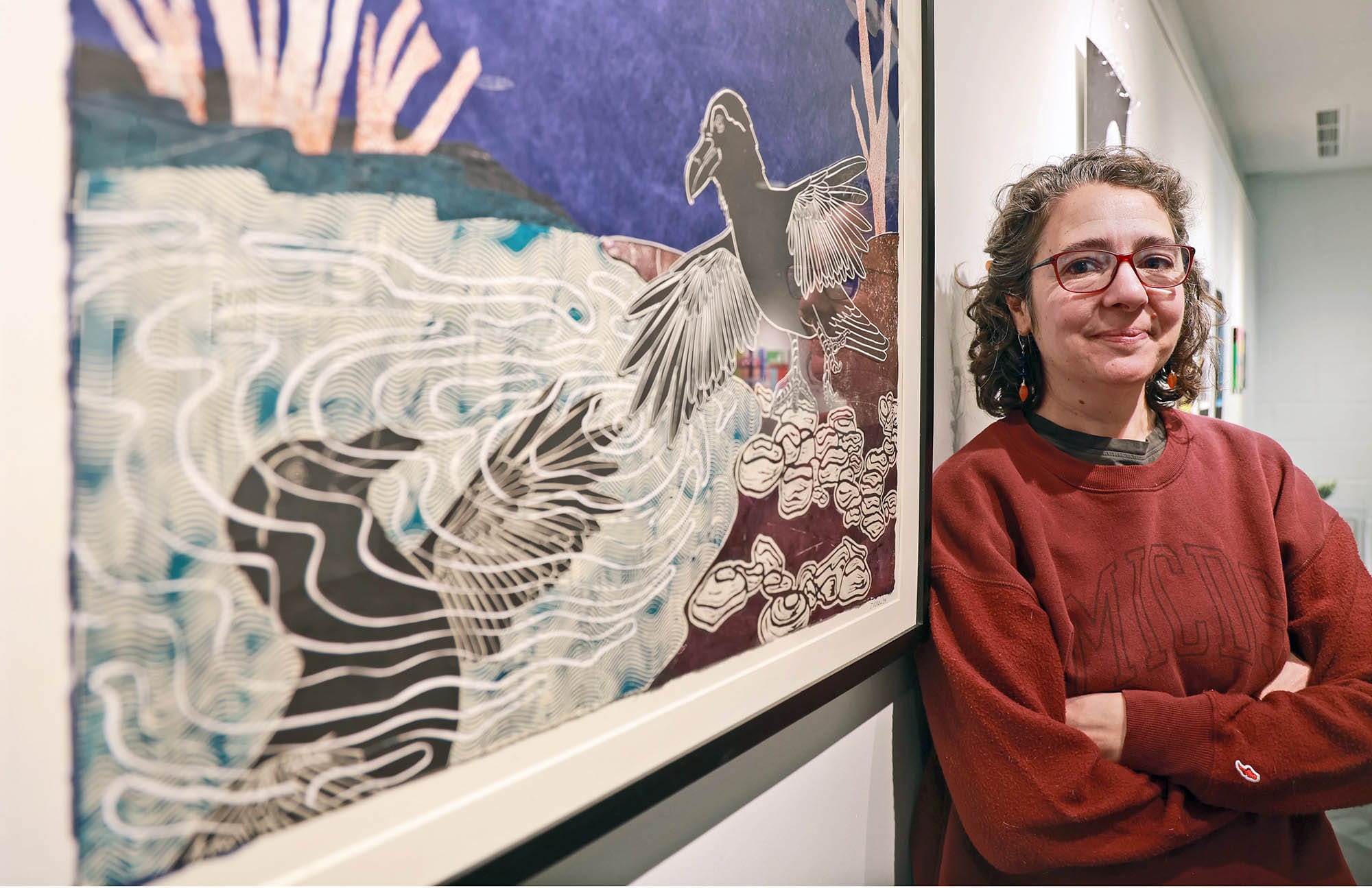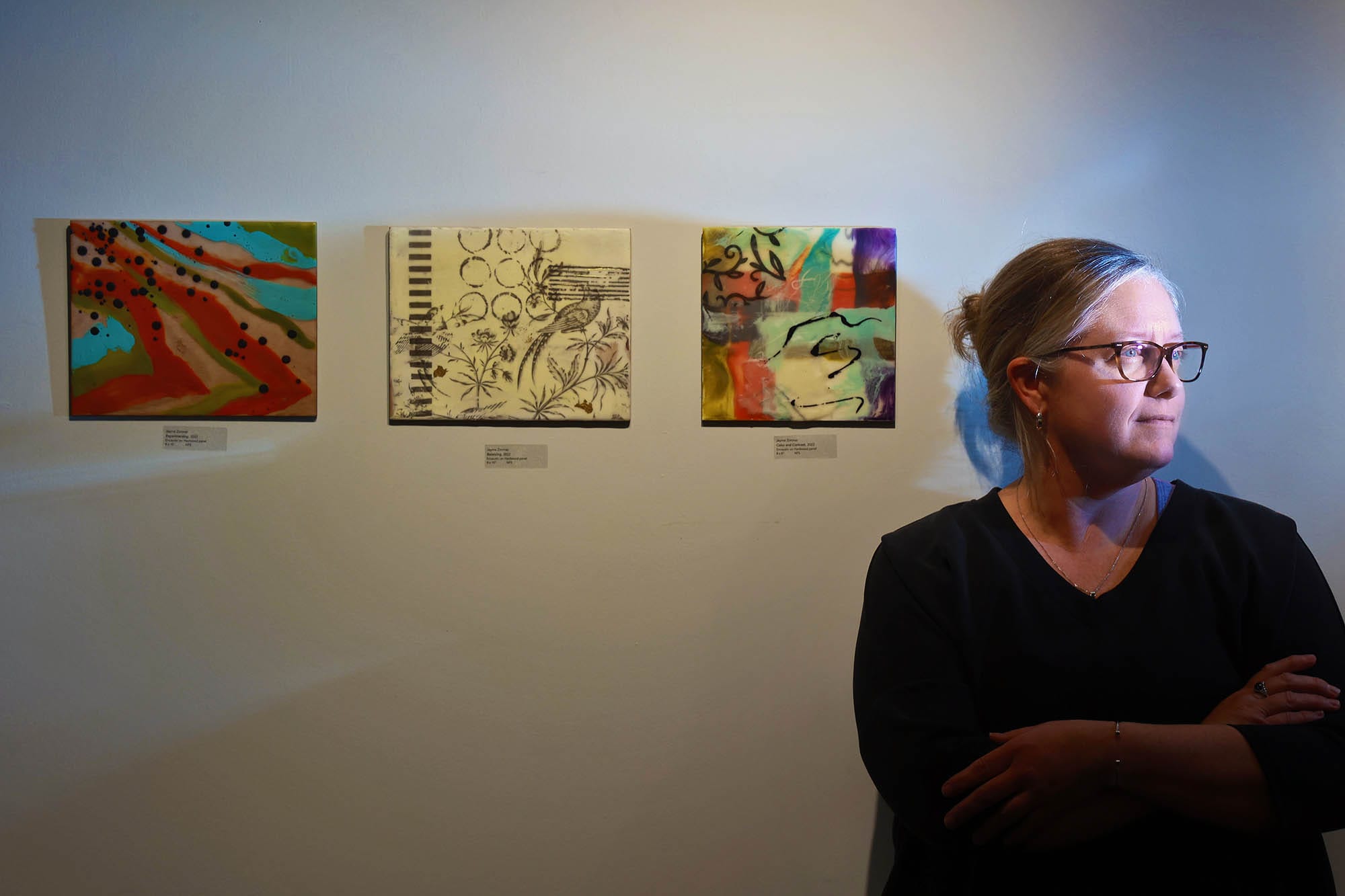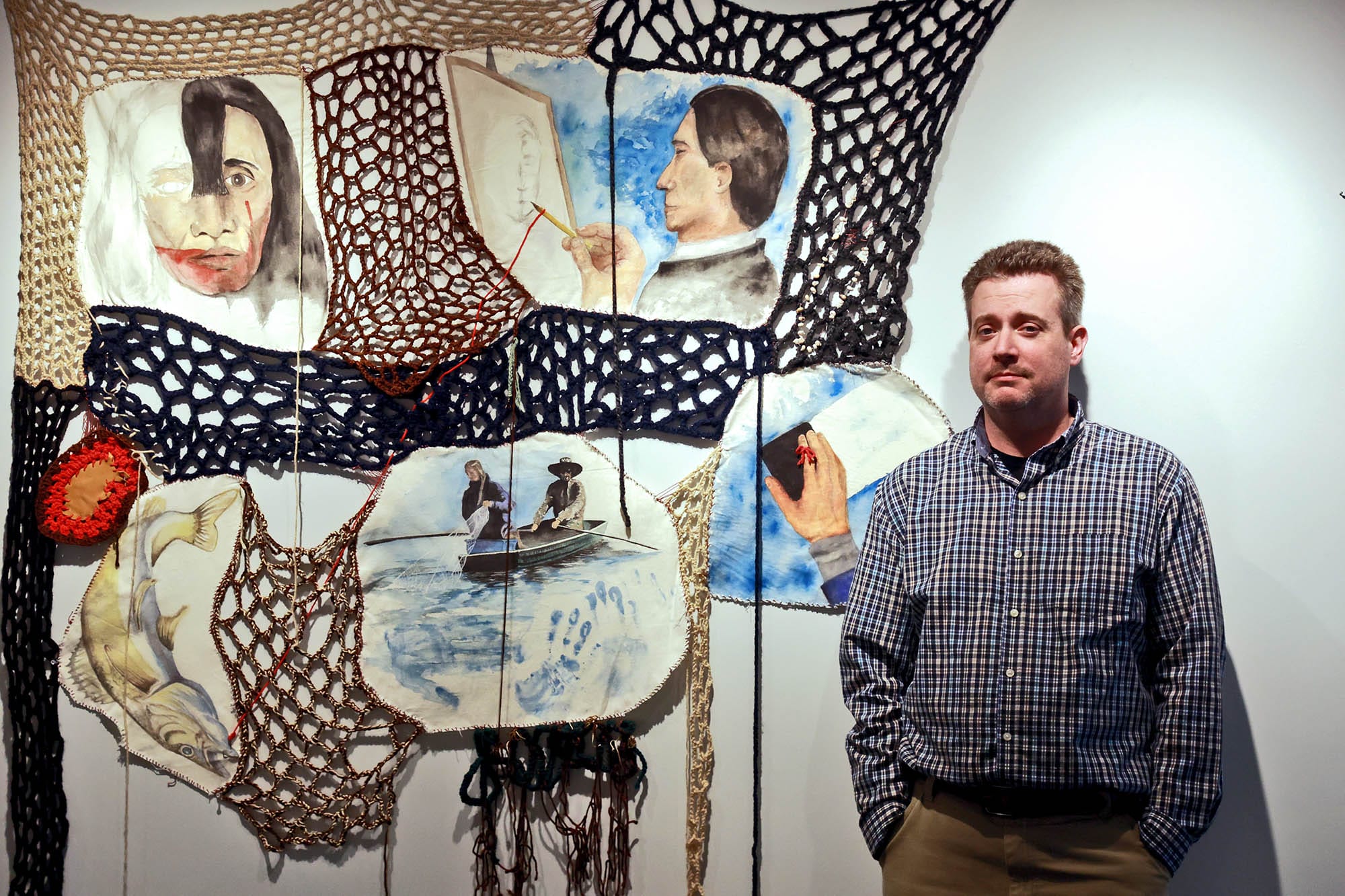While we are keenly aware on a daily basis that our amazing faculty and staff bring joy and creativity to our campus, did you know that they are also actively exercising their artistic talents outside of school? The work of 10 of our faculty and staff members is currently on display in Messing Gallery on the Upper School campus, inspiring colleagues and students through March 23. Friends, family members, and colleagues gathered in Messing Gallery on Friday, January 19, for an opening reception.
Our faculty have come to their creative lives via many different paths, but what they have in common is passion for life, creating and viewing the world in ways many of us couldn’t imagine.
Through ceramics, photography, printmaking, sculpture, painting, drawing, design, and fiber arts, our faculty and staff bring to the world beauty, documentation of our culture, and a uniquely complex understanding of the world around us. Please try to stop by the Messing Gallery before March 23 to enjoy the work of Brian Purlee, Patrick Huber, Denise Douglas, Brad Heinemann, Kevin Slivka, Brooke Williams, JoAnne Vogel, Jayme Zimmer, Sarah Garner, and Aaron Elliott.
Sarah Garner, Lower School Art Teacher
«My artistic practice revolves around a diverse range of media that reflects my daily engagement in creating alongside young artists and guiding them through the process of artistic expression. Through painting, printmaking, sculpture, and various other mediums, I aim to capture the dynamic and collaborative nature of the Lower School creative studio space. As an artist and teacher, my day is spent fostering an environment where young artists can explore their imaginations and hone their skills. I believe in the reciprocal relationship between mentorship and learning. The exchange of ideas, perspectives, and techniques between my students and me becomes a source of inspiration, driving the evolution of my artistic journey.
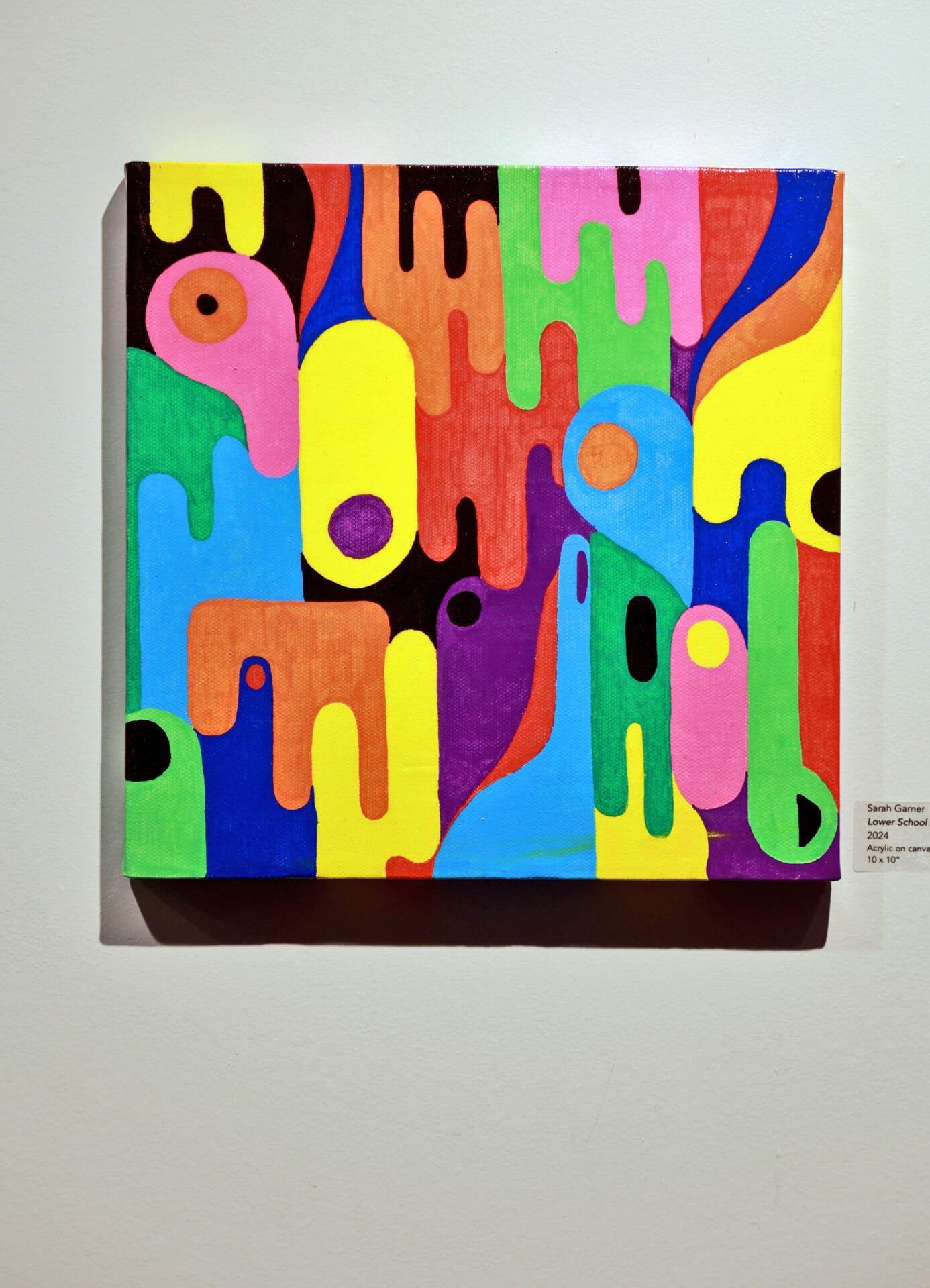
My commitment to teaching is interwoven with my commitment to continuous learning, as I absorb the insights and innovative approaches brought forth by the creative students I have the privilege to guide. I seek to celebrate the collaborative spirit that defines my daily interactions with these young artists. Through the exploration of various media, I aim to convey not only the tangible outcomes of our creative processes but also the connections formed through shared artistic experiences. My art becomes a testament to the transformative power of mentorship and the ever-evolving nature of artistic expression within a community of learners.»
Brad Heinemann, MFA, Upper School Art Teacher
«In my sculptural practice, I predominantly engage with welded and fabricated metal, channeling key Design concepts such as line, form, and contrast. As the son of a sheet metal worker, this medium resonates deeply with me, feeling inherently familiar.
The showcased artwork, titled Union, serves as a celebration of a friend’s marriage. It features two interconnected circular forms, characterized by continuous inward curves that serve as the foundational anchors of the piece.»
Denise Douglas, Upper School Art Teacher
«I have always been drawn to the imperfections in photography as a way to create more interesting and ambiguous imagery. I mostly shoot with a Holga camera. Entirely made of plastic (including the lens) and lacking any real control in exposure and focus, the Holga creates ephemeral photos that seem to lose their sense of time and place if the subject doesn’t give it away. The resulting photos speak to the past in often dreamlike images.
The images included in this show are from a body of work entitled As We Fade Away, which is the culmination of my past work with the Holga camera and is the result of a few early pieces that seemed to set the stage for what followed. As is often the case, rather than setting a particular goal of having something to express in mind, I find that my work tells me the story post-production.
As We Fade Away is the understanding of the impermanence of life. The Buddhist term for this is annica. The idea of annica holds that nothing remains the same, and everything is constantly shifting. The root of suffering (dukkha) comes from our need to hold tight to our ideas and avoid changes that come naturally as we move through this world. Buddhist philosophy tells us that in order to find peace (nirvana), we must let go.
It is important for students and the community to understand that we are professionals in our fields—that what we do goes way beyond teaching. Art is a lifestyle, a way to see the world on such a detailed level in an effort to understand and make sense of it. Art is therapy, it is happiness, it is expression and the oxygen we breathe.»
Aaron Elliott, MFA, Upper School Library Assistant
«I taught myself embroidery back in 1999, having pawed through my great-grandmother’s floss drawer as a young boy, dazzled by the choice of color. Having always been rhapsodic at the thought of ‘If you could invite five famous people to dinner, who would they be?’ I’ve made it my life’s work to create my own Dinner Party, totaling over 400 guests so far. From that time, I have painstakingly embroidered portraits of First Ladies and fraudsters, poets and pleasure-seekers, writers, Royalty, and rapscallions. Each portrait is one-of-a-kind and 100% hand done. One hundred percent of all proceeds benefit non-profit organizations. This is the first thing I do in the morning and the last thing I do at night. I’ve been using the same needle since the beginning (25 years). I live in Frenchtown, St. Louis, with my husband, Bill, and our Pug, Fanny.
I think it’s important for our students to see the adults of our community modeling what we try to instill. If I can help organizations with what talent I have, it’s a pleasure to do so. Creating my portraits, in a small way, helps to brighten the world one stitch at a time while also giving back.»
Brian Purlee, US Arts Maker and Science Teacher
«I attended the School of the Art Institute of Chicago and Indiana University for my undergraduate studies in Ceramics. Before and ever since receiving an MFA in Studio Art from the Pratt Institute in Brooklyn, New York, I explored the creative potential of technical theater along with my studio art experience. My artistic interests have remained in both Fine Arts and Technical Theater. Exploration of this relationship has necessitated studying multiple ways of knowing and making. I try to find a complementary ground among ideas, emotions, materials, and techniques. I generally work cross-disciplinary, currently under serial and post-modern influences. With these influences, I have continued to work with landscapes in painting and ceramics.
My current joy in ceramics crafting bottles and arranging them in scenes that mirror my fascination with landscapes. I am building horizontal bottles that allow for surface space, remembering my time and touch—recording the moments of plans and spontaneous marks. Vertical bottles introduce a subtle separation: a window or canvas for creating landscape-inspired marks. Platters for a stage, bottles as actors, a setting for viewing.»
Patrick Huber, Upper School Art Teacher
«I’ve had the opportunity to visit many wonderful places during my time as a teacher. I don’t think you really SEE a place, though, until you’ve sat down and drawn it. These are from the sketchbooks that I’ve taken on my travels and include details like the Weeping Angel of Amiens, which was a favorite of American GIs in France, and an expansive view of the Tuscan landscape from my 2022 visit to Italy.
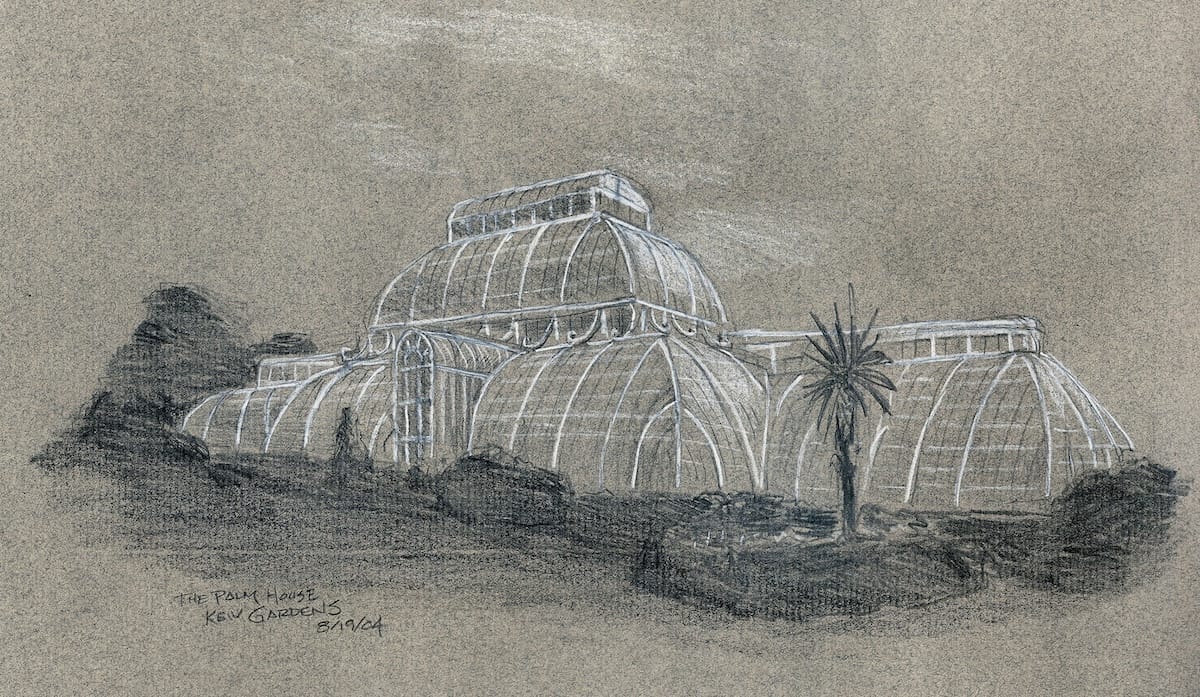
My favorite thing about sharing my drawings with our students is that they are evidence of the value of practice and passion over ‘talent.’ My fine motor skills have always been questionable—I’m not a graceful person at any sort of physical activity. I love to design, though, and so I’ve put in many, many hours of drawing. I’ve gotten to the point that I can create a reasonable facsimile on paper, either of a famous monument I’m trying to understand or a design idea that, until I draw it, exists only in my mind.»
Brooke Williams, Upper School Art Teacher
«During the pandemic, I found that keeping social distance from students became one of the most difficult struggles of all my years of teaching. My routine is walking around the studio and checking in with students frequently. Making those connections is one of the most rewarding aspects of teaching. So, I found that keeping my hands busy allowed me to stay in place, distanced.
I found solace and resilience in the tactile construction of each hand-built brick and the details in the surface designs. The challenges and uncertainties of these times created space to focus on the rhythm of shaping and molding clay––my own art therapy. Building these bricks offered a sense of control when so much felt beyond it. These bricks, quilt-like in their display, became an art therapy that warmed me during a very trying time.»
JoAnne Vogel, Middle School Art Teacher
«I have always been fascinated by lines and edges. As a young artist, I spent many hours creating drawings consisting of single long lines that wrapped themselves around objects, showed corners and edges, and created spaces and places. I used very little color on these pieces. I loved the challenge to create them and the simplicity of using a single pen on the paper.
While still focused on this artistic technique, an opportunity came up for me to travel to Niger, Africa, and live for two months in the desert town of Sassoumbroum. Things changed after that trip. Being surrounded by nothing but dry, red earth and sand causes one to crave even a hint of color and pattern, and while living there, I found myself actively searching for it in my surroundings. I became fascinated by the contrast of the intense patterns found in the local fabrics, the unusual textures in the piles of dried goods in the market, and the miles and miles of dry, red earth. Upon returning, I was drawn to red terra cotta clay, which served as a perfect background for the pattern and texture I had spent so long observing. I spent years following that trip working with these elements. That trip was an integral part of finding my artistic vision and path. The patterns and textures have continued to appear in my art for decades, bringing surface design to my ceramic work, texture to my photography, and repeated pattern to my printmaking and digital pieces. More recently, I have continued focusing on the lines, patterns, and textures to communicate the human experience.
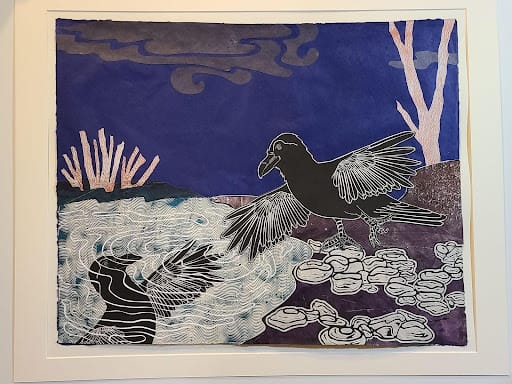
This illustration, Raven contemplates her reflection, shares the chapter of grief where we realize that the world is the same, yet different, after loss. It is both devastating to acknowledge the difference, and an opportunity to shift your relationship with yourself and the universe. This new state presents questions: How has this loss changed me? What choices will I make now? What are my priorities? Where will the physical and emotional energy I had for that person be directed? Raven is starting this process by looking at her reflection and seeing herself. She is understanding who she was, and discovering who she can become.
The piece is constructed of multiple elements. The full raven is a linoleum block print. The raven reflection is the same drawing, but actually a second carving, done in reverse to represent her reflection. The rocks are the third linoleum print. The rocks were printed as a block print, but texture was incorporated into the ink in the background areas before running it through the press. The water is gelli plate mono printed and was glued together with the reflection bird before the water lines were cut into both layers. I removed a thin layer of each piece to create the water ripple look. Additional gelli plate monoprinting textures were added to the foreground areas of the rocks and at the base of the shrubs. I created the tree and shrub branches with gelli plate monoprinting as well. The solid areas are colored rice papers. Printed papers are Mulberry, Kitakata, and Rives.»
Jayme Zimmer, Middle School Art Teacher
«I am an artist and a teacher. I spend most of my days introducing and practicing art concepts and skills with students. That work spans across many processes and media. Although I am labeled a teacher, I really see myself as a ‘forever student,’ inspired by images I see in nature and from other artists, including my own students. I have created a large body of work throughout my life covering a wide range of concepts and media. I know what inspires me the most is pattern, all kinds but especially found in nature. I also love changing something that already exists to put my own spin on it, creating everlasting connections to the living world, people, and the past.
Artwork for this exhibit: I took a weekend to learn about and experiment with a new medium to me: encaustic. During this process, I got to be inspired by designs contributed by other artists, mostly in the form of paper. I collaged, inked, transferred, waxed, and worked with a room full of other artists who I got to exchange ideas with all throughout our time together. I would like these pieces to represent trying something new, recycling other artists’ work into new expressions of my own, and the joy of being with others in the process…what I ask of my students every day.»
Kevin Slivka, Upper School Art Teacher
Keeper, 2018
«The stone sculpture by Duane (Dewey) Goodwin [White Earth Band of Anishinaabe] entitled Sacred Bowl, placed within the Indian Mounds Park, St. Paul, Minnesota, has inspired this print edition. Goodwin carved the eight-foot stone grandmother during the International Stone Carving Symposium, ‘Minnesota Rocks!’ in 2009, which directly faces the Indian burial mounds. Thirteen Indigenous burial mounds remain in the park; it has been estimated that 26 were once present. Sacred Bowl centers on relationships to land imbued with sacred respect, intimately intertwined with cultural identity and ceremony and informs an ongoing active relational orientation to knowing and being. Sacred Bowl is a keeper that watches over those who have passed while marking active Indigenous presences. Prior to producing this print edition, I asked for and received Dewey’s permission to reproduce an image of his stone sculpture. This particular composition notes the Euro-American orientation to land during Western expansion, which entailed burial disruption, extraction, and destruction. The selected images are reproduced drawings from De Montreville’s 1867 excavation of Mound #3, which is incorrectly identified as Mound #2. The theme of ‘Protect This Land’ addressed in Keeper draws viewers’ attention to the competing orientations that continue to inform our relationships to land, while asking, “In which place do my values exist?”
Seeking through Water, 2019
«Water formations are relational to land and are in constant reciprocal engagements with the land. Water exists and flows, contingent on the ecology and vice versa. This print edition is inspired by water, both in art process methodology and in content. The arts methodology was framed by the following phenomenological questions: ‘How do I pull a puddle?’ In other words, ‘How can I manipulate acrylic screen printing ink to act as a puddle through the screen on paper?’ My methods varied as I considered breaking with traditional techniques, emphasizing stuttering, uneven inks, and smooth movements on an unadulterated screen. As a result, each print generated a unique outcome driven by the methodological question. An additional image layer was pulled, a representational derivative of Michael, our first child, standing in a puddle; the quiet moment of him studying the reflections in the water just before he jumped and splashed in the water, generating ripples throughout the puddle. The juxtaposition between phenomena and representation is intentional in this print edition, as was Michael’s engagement with the puddle, though I believe Michael’s rules of play simply involved exciting his environment. Similar to water being a gift for life, this ‘Heart Path’ print was made as a gift that questions ‘Truth’ with many truths that emphasize differences inherent to experience, culture, and place.»
Partial access, 2011
«The crochet netting is stitched as a binding agent, which connects historical and visual ideas together as a web of social relations defined by power|knowledge structures. These juxtapositions generate tensions characterized by suppressions and resistances. Each representation alludes to either a specific event or metaphoric symbolism. The partial representation of George Catlin’s painting of Buffalo Bull’s Back Fat resists completion, connotes the ideology of a ‘vanishing race,’ Catlin’s own positionality, and emphasizes partiality and possibility for reinvention.
Juxtaposition is utilized throughout the collage; reappropriating assimilationist imagery from the boarding schools against the representation of a walleye fish holds in tension contrasting worldviews. Assimilationist efforts during the late 19th and early 20th centuries were institutionalized through the government boarding schools, where students were disconnected from their families, their culture, their language, their material culture, and their ways of life. Further tensions reveal efforts of instilling a Christian ideology that acted as erasure and silencing denoted by the hand that is wiping away the water. A red string is tied to a finger, evoking remembrance.
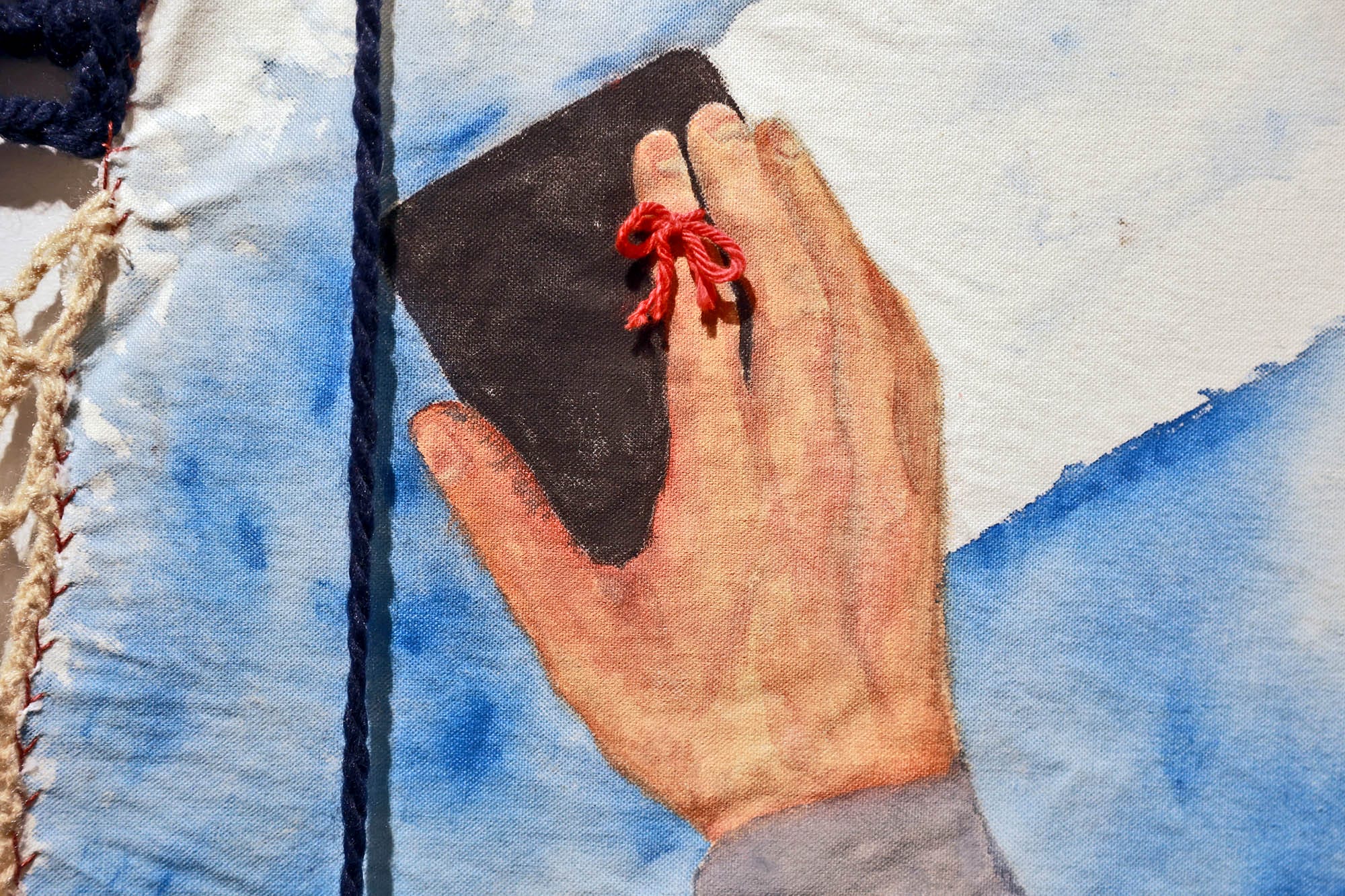
A small group of Ojibwe on Lake Bemidji in May 2010 cast hand-made fishing nets from boats into the lake a day earlier than the DNR-regulated fishing season. The usufructuary demonstration was disrupted by the DNR, who pulled, collected, and cut the nets. The demonstrators were issued citations rather than being arrested. Their intention was to initiate judicial action pertaining to the ongoing inequity and failed treaty promises of usufructuary rights retained by the Ojibwe peoples. Ojibwe usufructuary rights to hunt, fish, and gather on ceded territory were to be guaranteed through federal treaties, which are now controlled and managed by the state’s Department of Natural Resources (DNR) regulations. Even though this political demonstration failed to generate judicial action, it created ripples throughout the surrounding communities and opened up the discourse pertaining to treaty rights.
The imitation leather bison, stitched into the web, is in relation to notions of cultural erasure and an intentional affront to disrupt the local ecology, which supported numerous Indigenous tribes’ ways of living. A singular seed-beaded form represents the development of paddy rice which is genetically modified for easier harvest, signals the commodification of Indigenous practices of harvesting wild rice (manoomin) with knocking sticks and canoes. The final panel consists of my handprint, which was created as a means of finding my place within these relationships.»
